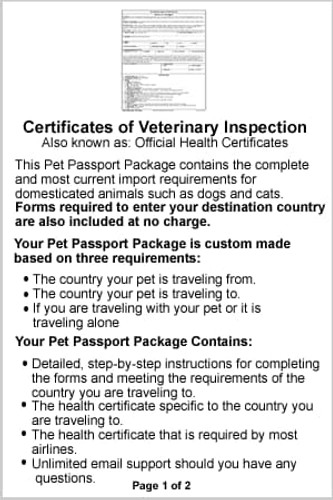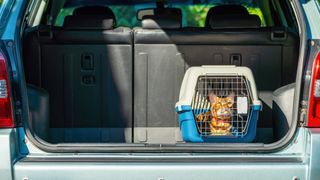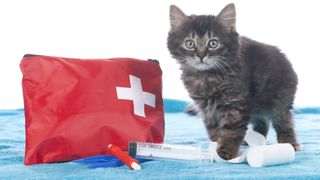(239) 344-8959
Client Portal

- How it Works
- Cat Transport
- Corporate Pet Relocation
- Dog Transport
- International Pet Transport
- Military Pet Relocation
- US Domestic Pet Transport
- US Pet Imports
- Pet Protection Plan
- Testimonials
- Why Choose Starwood?
- Country Pet Travel Guides
- Frequently Asked Questions
- Travel Kennel Calculator
- State of Pet Travel Annual Report
- Destinations

Moving a Pet to Spain
Rules and regulations for international pet shipping, rabies vaccinations, other vaccines, blood tests, health certificates, import permit, tapeworm treatment, banned breeds, age restrictions.
- Microchip for Pet Travel to Spain
- Quarantine for Pet Travel to Spain
Pet Carrier Measurement Guide
Ultimate guide to moving pets, international airline pet policies, top destinations in spain.
- How Starwood Can Help
What Pet Travel Documents Are Needed to Travel to Spain?
All countries create their own rules for importing pets if you plan to visit or relocate to their country. The rules are similar in many ways, but the details often vary according to where you live now. For example, if you and your cat, dog, or ferret reside in another European Union country and your pet already has a current EU Pet Passport , you will not need any additional paperwork to bring your pet into Spain.
If you currently reside outside the European Union, there are several steps you will need to take in order to move your pet to Spain – again, depending on where you’re coming from. If that’s the US, this USDA web page explains what you will need to do. To make it easier for you, though, we have pulled together all the essentials below.
It is critical that you understand and follow the requirements to the letter. Pets that arrive without proper documentation can be sent home, quarantined, or even euthanized. No country wants an incoming animal to bring pests or diseases.
If your pet will not be traveling with you, you must also sign an authorization form for whoever will accompany or transport your pet.

Other than rabies, Spain does not require specific immunizations to import pets. Nonetheless, once you have arrived in Spain, you should ask your veterinarian about preventive measures for locally common pests or diseases.
It is recommended that cats and dogs are vaccinated for the following. Do note that if your pet will be boarding, these vaccinations will be required.
- Dogs : DHPP (Distemper, Hepatitis, Parainfluenza, Parvovirus), Bordetella (Kennel Cough), Leptospirosis, CIV (Canine Influenza Virus)
- Cats : FVRCP (Feline Viral Rhinotracheitis, Calicivirus, Panleukopenia), Feline Leukemia
If your pet is traveling from an "unlisted" country, then a rabies titer blood test will be required. The rabies titer test must be completed at least 30 days after their rabies vaccination and at least 3 months before traveling to the EU. This test must be completed by an authorized (USDA-Accredited) vet and the sample must be sent to an EU-approved laboratory .

Every pet entering Spain must have their own health certificate. It must be completed and signed by an accredited veterinarian and then endorsed (counter-signed and stamped or embossed) by the USDA APHIS Veterinary Medical Officer in your state. Spain will allow the accredited vet to electronically complete/sign the health certificate, but the USDA or government endorsement must be in original ink.
This document must be completed within 10 days prior to your pet’s arrival in Spain.
You will not need a separate import permit to bring your cat or dog into Spain. Exceptions to that are if you plan to import more than 5 pets or if your pet will arrive in Spain more than 5 days prior to or after your arrival.
Spain does not require tapeworm treatment prior to importation. However, be aware that if you plan to travel with your dog to the UK or some other EU countries after you’ve moved to Spain, a tapeworm treatment will be required.
What Are the Pet Restrictions for Spain?

Although many countries ban certain breeds of dogs and/or cats, Spain does not. However, if your dog is one of the following breeds, you will need to muzzle them to go through security and register them within 3 months of arrival:
- Pit Bull Terrier
- Staffordshire Bull Terrier
- American Staffordshire Terrier
- Dogo Argentino
- Fila Brasiliero
Spain does not allow the importation of kittens, puppies, or baby ferrets that are less than 12 weeks old and have no rabies vaccination, nor do they allow those between 12-16 weeks whose rabies vaccine is less than 21 days old at the time of arrival.
Do I Need a Microchip for My Pet to Travel to Spain?

- Carry a chip reader that customers officials can use to scan your pet, or
- Notify Spanish customs ahead of time so they can have the right type of scanner available
What Are the Quarantine Requirements for a Pet Traveling to Spain?
As long as your pet meets all of Spain’s import/health requirements, there will be no quarantine upon entering the country.
FAQs on Pet Travel
- Madrid, Spain
Our Top Blogs About Spain
How to Find Like-Minded Pet Parents in Spain
Keeping Up with International and U.S. Airline Pet Shipping Policies: The Ultimate Guide
Best Dog Beaches In Europe
6 Summer Vacation Spots to Enjoy with Your Pet in Europe
Our Spain pet shipping services include:
- Door-to-door transport
- Assistance with health certificates, import certificates, and other travel documents needed for animal transport to Spain (outlined above)
- USDA endorsement and consular legalization (when needed) of all relevant documents where required
- Airline-approved flight kennels provided with personalized labels, identification and emergency notification instructions
- Customs clearance and delivery to your home
- Local pet taxi service to and from the airport, your home, veterinarian, kennel, or groomer – available in major Spain cities as well as their surrounding areas
- Travel consultation and flight reservations
We will inform you of your pet's full itinerary before the trip and we will update you as your pet travels to Spain .
Request a FREE Quote
Guide on taking dogs to Spain [Pet Passport Requirements 2023]

Taking dogs to Spain is pretty straightforward. You will need to get your dog an EU Pet Passport . Dogs, along with cats and ferrets, are eligible for an EU Pet Passport which allows them to enter the EU and travel freely between EU and certain listed countries. This involved getting your dog microchipped and vaccinated against rabies at minimum. Secondly, you will need to organise travel. You can either enter Spain in a car or by air. Traveling by car is more straight toward than traveling by air. This is because airlines have strict rules and requirements for taking pets on their planes.
In this article, we will discuss in detail the process of taking a dog to Spain. Additionally, we will walk you through the process of obtaining a Spain pet passport and all the documents required.
TABLE OF CONTENTS:
What is a Spain Pet Passport?
- Visiting the vet
- Driving to Spain with a dog via The Channel
- Getting a ferry directly to Spain with a dog
Flying to Spain with a dog
- Microchipping
- Rabies vaccination
- Rabies titer test / rabies blood test
- Health certificate
- How much does taking a dog to Spain Cost?
Taking dogs to Spain for commercial reasons
- Guidelines for dog carriers
Can I take my puppy to Spain?
What if i lose my spain pet passport.
- Can I travel to Spain without a Spain Pet Passport or EU Pet Passport?
- Can I fly with my pet in the cabin of the plane?
Bottom Line
A Spain Pet Passport is a compilation of documents that your dog needs in order to travel to Spain. With an EU Pet Passport , dogs are able to travel throughout the EU without enduring a quarantine period. Dogs will require a microchip and rabies vaccination at minimum, proof of both is needed in order to obtain an EU Pet Passport . All documents must be issued by an accredited veterinarian. Essentially, a pet passport demonstrates that your dog is fit and healthy to travel.
The documents required to travel with dogs depends on which country you are travelling from, and which country you are travelling to. Each country has individual rules and requirements to export and import dogs. We will discuss the requirements to travel with dogs to Spain in detail below.
What does an Spain Pet Passport contain?
A Spain Pet Passport, or EU Pet Passport contains all the documents required to travel with your dog. Essentially, it will prove that your dog is fit and healthy to travel and doesn’t pose as a health threat to other dogs.
A Spain Pet Passport contains the following information:
- Details of ownership (name, address, passport number, telephone, etc.)
- Description of the animal (name, species, breed, date of birth, etc.)
- Official veterinarian’s details
- Microchip information
- Rabies vaccination certificate
- Rabies antibody titer test results
- Parasite treatment records
- Additional vaccination and treatment records
- Pet photo (optional)
At minimum, your Spain pet passport will contain those listed 1-5. These are compulsory in order to travel within the EU with a dog. Those listed 6-8 are potential requirements that your dog may need, depending on where you are traveling from. For example, if you are traveling from outside the EU, from high-risk rabies countries, your dog may need a Rabies Blood Test (also known as Rabies Titer Test).
All records are signed and stamped by your official EU veterinarian with official stickers from the medication used.
What is the process of taking a dog to Spain?

VISIT THE VET
You will need to visit the vet to obtain your dog’s Spain pet passport.
Before booking your appointment, it is helpful to check that your chosen vet is authorised to issue EU Pet Passports . Not all of them are.
At your appointment, your vet will administer your dog with a microchip and rabies vaccination, if your dog hasn’t already had them. They will also check your dog’s overall health to ensure that he or she is well enough to travel. Once the veterinarian is satisfied that your dog is ready for travel, they will review all the paperwork and complete your dog’s pet passport booklet.
You will need to bring the following to the vet appointment:
- Your passport
- Your local address
- Microchip information (if your dog already has one) – date of implantation, chip number and issuing company information (this info is also on the Annex IV)
- Dog’s rabies certificate or rabies titre test results no less than 21 days old (if your dog has one)
- Annex IV form completed by your home vet and endorsed by your country’s official veterinary regulatory body (if you are from outside the EU)
- Dog photo (optional but recommended) – the size should be 2 x 2 inches (5cm x 5cm). It is better to have one as you do not want to give any customs official a reason to deny your dog entry into a country.
If your dog hasn’t yet been microchipped or vaccinated against rabies, don’t worry, your vet will complete these at the appointment.

ORGANISE TRAVEL
For a stress free journey, you will then need to plan out how you are traveling to Spain. The easiest option is to travel by car and ferry, however you also have the option to fly to Spain. Flying to Spain with a dog is far more complicated as airlines have very specific rules and regulations when it comes to traveling with dogs. Additionally, some airlines even prohibit certain dog breeds from boarding their planes.
There are a few options to take dogs to Spain:
- Driving to Spain via the Channel
Taking a ferry directly to Spain (with a car)
Driving to Spain via The Channel
You can drive your dog to Spain from the UK, either via the Eurotunnel, or by taking a ferry to France. From there, you can drive through France to Spain.
This is a long route and will end up being quite expensive, however it is a straightforward option for taking dogs to Spain. Additionally, it is convenient to have your own car with you on your trip.
To cross The Channel, you have two options:
- The Eurotunnel; or
- Taking a ferry, such as between Dover and Calais.
If taking the Eurotunnel, it costs an extra £19 per pet. Most ferries will charge a similar price. For more information, check my extended post on How to take a Dog on The Eurotunnel [Guide, FAQ & Prices] .
Whichever option you choose, be sure to let the company know that you will be bringing your dog with you. It is best to do this well in advance to ensure for a smooth journey.
Many ferry companies require dogs to stay inside vehicles, which is why foot passengers are not permitted to bring dogs.
Once you arrive in France, you will need to drive through the country to arrive in Spain . The journey typically takes one or two long days of driving. Calais to San Sebastian is just over 1100km (700 miles), while Calais to Barcelona is about 1300km (800 miles).
If you have a car you can take a ferry directly from the UK to Spain, with Brittany Ferries. This is only an option with a car as foot passengers are not permitted to bring dogs.
In order to skip the long, one or two day drive through France, you can get a direct ferry. The available routes are from both Portsmouth and Plymouth to Santander, plus Portsmouth to Bilbao. The journey is rather long taking between 20 and 32 hours, depending on which ports you are sailing between.
Unfortunately, this is only an option for those taking dogs to Spain with cars. This is because foot passengers are not allowed to take dogs on any Brittany Ferry route.
Brittany Ferries offer pet-friendly cabins and kennels on 4 of their ships – Cap Finistère, Connemara, Etretat and Normandie. Additionally, all pet-friendly ferries have designated areas to exercise your dogs. When in these designated areas, dogs must be muzzled and put on a lead.
If you are not traveling from the UK, or you do not have a car, it is usually an easier option to fly.
Taking dogs to Spain via air can be complicated because airlines have strict rules, regulations and restrictions when it comes to traveling with pets. There are some airlines will not allow dogs to travel on their planes at all, however there are some that will.
Traveling via air can be expensive too, as you will need to pay extra to ship your dog. The price will vary between airlines, and depending on the weight and size of your dog.
1. Before booking your flight, be sure to check out different airline’s policies to ensure that you are able to take your dog with you.
Some airlines may allow your dog to travel in the cabin with you, where others will require dogs to travel in the cargo area of the plane. If you have a small dog, then you may be able to take them in the cabin with you. However, if you have a large dog then he will need to fly in the cargo.
- 13 Airlines That Allow Flying With Dogs In-Cabin [2020 Prices & Policies]
- 13 Airlines That Allow Flying With a Cat In-Cabin [2020 Prices & Policies]
- Which Airlines Allow Ferrets In Cabin? [2020 Policies & Prices]
- 13 Airlines That Allow Pet Birds on Planes [2020 Policies & Prices]
- 7 Airlines that Allow Rabbits in the Plane Cabin [2020 Policies & Prices]
2. When booking your flight, inform the airline that you will be bringing your dog with you.
Do this as soon as you book your flight, as airlines often have limitations on how many dogs they can ship at any given time.
3. Be sure to get an appropriate travel carrier and get your dog used to spending time in it.
Different airlines have different size and weight restrictions when it comes to dog travel carriers. Be sure to check those of your chosen airline. If traveling in the cabin of the plane, the carrier must be small enough to fit underneath the seat in front of you.
To ensure that the journey is as stress-free as possible for your dog, ensure they are comfortable in their travel carrier. You can do this by taking your dog on short journeys in it’s travel carrier. Take your dog out to lunch with you in its carrier, or take it to your friends house for a coffee. This way the longer journey will not be so stressful.
4. If traveling from a non-EU country, you must enter Spain through international airports in Barcelona, Madrid, Malaga, Tenerife Sur or Valencia.
Accompanied pets entering Spain by air from non-EU countries must do so at Border Inspection Posts at international airports in Barcelona, Madrid, Malaga, Tenerife Sur or Valencia. Ports approved for the import of pets are: Algeciras, Almeria and Santa Cruz de Tenerife.
All domestic dogs must be free of evidence of disease communicable to humans when examined at the port of entry to Spain. If your dog is not in apparent good health, further examination by a licensed veterinarian may be required at your expense.
Pets may arrive in the cabin, as checked baggage or as air cargo.
What are the requirements for taking a dog to Spain ?

In order to take your dog to Spain, your dog requires the following:
REQUIREMENT 1: MICROCHIPPING
All dogs must have a microchip in order to obtain an Spain Pet Passport.
A microchip is a electronic chip that holds a unique number traceable with a chip reader. It is place just under your dog’s skin in between its shoulder blades.
We recommend that this is the first step in the process of obtaining a Spain Pet Passport, or EU Pet Passport. This is because if your dog isn’t microchipped before they get their rabies vaccination, then the vaccination may not be valid. Therefore, this would therefore mean your dog would have to get vaccinated again.
REQUIREMENT 2: RABIES VACCINATION
All dogs must be up to date on their rabies vaccinations in order to obtain a Spain Pet Passport.
In order to get a Spain Pet Passport, you must be able to prove that your dog has had their rabies vaccination.
The timing of your dog’s rabies vaccination is important, depending on where you are traveling from. If you are traveling from a rabies controlled country , your dog must be vaccinated no sooner than 21 days of entering Spain. However, if you are traveling from a high-risk rabies country , you must wait for a minimum of 30 days after the primary or booster vaccination before receiving a rabies titer test (see next requirement 3).
Spain accepts the 3 year rabies vaccination for dogs. However, it should only be applied as a booster and not as their initial vaccination.
Rabies-controlled (listed Third) countries as classified by the European Union:
High-rabies (non-listed Third) countries as classified by the European Union:

It may be possible that you require the following:
REQUIREMENT 3: RABIES TITER TEST
All dogs traveling from a high-risk rabies country , must pass a rabies titer test (rabies blood test).
A rabies titer test is a blood test to see whether your dog’s rabies vaccination was successful. Your veterinarian will need to take a blood sample at least 30 days after the rabies vaccination. The sample will then be sent to an EU -approved blood testing laboratory . The blood rest results must show that the vaccination was successful – i.e. your dog’s blood must contain at least 0.5 IU/ml of the rabies antibody.
You must then wait 3 months before your dog can enter Spain. If you do not wait 3 months, then your dog will be quarantined in Spain for the remainder of the time.
REQUIREMENT 4: HEALTH CERTIFICATE
You will need a health certificate if:
- You are taking dogs to Spain from outside the EU, for non-commercial reasons; or
- You are taking dogs to Spain for commercial reasons
Commercial reasons include taking dogs to Spain for resale or adoption, or if you are not traveling with your pet within 5 days.
An official veterinarian must complete an EU Health certificate for Spain, in English, or translated to English.
Your health certificate must be endorsed by your home country government agency responsible for the import and export of pets. For example, in the US you will need to have your health certificate endorsed by the USDA. In Canada, this will be the CFIA.
The form is to cover transport of up to 5 dogs and is valid for 4 months, as long as your dog’s rabies vaccinations are in date.
How much does it cost to take a dog to Spain?
The cost of a Spain Pet Passport is usually around £60-£100. The cost is broken down into the following costs:
- Microchipping – £0-20
- Rabies vaccination – £0-20+
- Pet passport application – £60
Firstly, different countries and veterinary clinics will have different pricing for a pet passport. If you wish to save money, check the prices of a few different veterinary clinics. Some will also offer pet passport packages.
If your dog already has a microchip, and a recent rabies vaccination, you will probably pay less for your Spain pet passport. This is because you will only be paying for the health check and the documents.
For more information on the cost of an EU Pet Passport , check How much does an EU Pet Passport cost in 2020? .
For information on how to get free microchipping in the UK check How to get Dog Microchipping for Free in the UK [2020] .
Any dogs being transported for commercial reasons, such as adoption and re-sale, require the following:
- Valid rabies vaccination;
- Undergo a health examination and be accompanied by an Annex I Health Form;
- Be accompanied by original paperwork, signed by a licensed vet; and
- A successful rabies titer test result.
Dogs are only permitted to enter Spain from a high-rabies country if they are accompanied by their owner or a legal representative of the owner.
DOCUMENT ENDORSEMENT
A licensed veterinarian must complete the English version of the commercial EU health certificate for Spain within 48 hours of entry. If your dog is traveling from the US or Canada, the veterinarian must be accredited by the USDA or CFIA respectively and the commercial EU health certificate must be endorsed by the local USDA or CFIA office unless the certificate is completed by a military Veterinary Corps Officer or GS-0701 series civilian government veterinarian employed by the military. If traveling to Spain from another country, then the forms must be endorsed by the government agency responsible for the import and export of animals.
Which dog breeds are banned from entering Spain?
There are no banned dog breeds in Spain, however the following dog breeds must be muzzled and registered within 3 months of entry:
- Pit Bull Terrier
- Staffordshire Bull Terrier
- American Staffordshire Terrier
- Dogo Argentino
- Fila Brasiliero
Owners of these dog breeds are responsible for their dog’s actions, and are liable for injuries or attacks.
Additional info for taking dogs to Spain
- You can legally take a maximum of 5 dogs with you.
- Dogs younger than 15 weeks old cannot enter Spain.
- When you take your dog for a walk, you should carry bags to collect your dog’s excrement . Otherwise, you could face high fines.
- In Spain there is a general obligation to use a dog belt or harness in cars . If you’re driving, find out beforehand how you should take your dog in the car.
- In Spain, ticks and lice that can transmit dangerous diseases are widespread in many regions. It is therefore advisable to provide your pet with adequate protection against ticks, and make sure they’re vaccinated against certain Mediterranean diseases such as leishmaniasis .
- Dogs are banned from many official beaches in Spain during the high season in summer.
- Dogs are allowed in some hotels, but not in many. It often depends on the size and number of dogs. In restaurants, dogs are usually not allowed . If it’s a small, quiet dog, some restaurants will let you through with it.
- Dogs are not allowed on public transport in many cases . On Spanish trains, they are sometimes allowed to travel in a box in the luggage trolley. Dogs are not allowed in public buildings and administrative offices unless they’re guide dogs
Guidelines for Dog Carriers
If you are flying to Spain with a dog, it is important that you use a dog carrier that is approved by your airline. Different airlines have different pet carrier policies, which often vary between aircrafts and routes. Check that your pet carrier is approved for your chosen airline, aircraft and route.
The rules and regulations have been set out by International Air Transport Association (IATA) ensure that dogs are comfortable when travelling. Thus, inside their travel carriers, dogs must be able to stand up, turn around and lie down in a natural position in their kennel (without touching any side or the top of the container).
The rules for pet carriers also vary depending on whether your dog will be flying in the cabin or cargo area of the plane.
If you are travelling in the cabin with your dog, then you will need to ensure that it fits under the seat in front of you. This is why only small dogs weighing under 7-8kg are permitted in the cabin.
Furthermore, airlines often require that your dog must be obedient to your commands and must behave appropriately in public. Thus, he mustn’t bark or growl at other passengers or staff. If your dog does not behave in an appropriate manner, some airlines may transfer him to the cargo hold at an additional cost, or refuse to transport him all together. Some airlines require a consent form to ensure your pet is flight-ready.
For a list of airlines that allow dogs to fly in the cabin with their owners, check 13 Airlines That Allow Flying With Dogs In-Cabin [2021 Prices & Policies] .
Frequently Asked Questions [FAQs]
Yes, as long as your puppy is at least 4 months old. This is because Spain requires dogs to be vaccinated against rabies, which can only be administered to dogs over the age of 3 months. You must then wait 21 days after the vaccination, before entering Spain. Additionally, proof of age should be available.
Can I travel without a Spain Pet Passport or EU Pet Passport
Yes, you may enter Spain without an Spain Pet Passport or EU Pet Passport as long as you have an EU Health Certificate (also known as EU Annex III Health Certificate.
If a passport is lost or stolen, it can be replaced as long as you have evidence of the animal’s vaccination record and blood test result (if applicable). Both records must also show your dog's microchip number. Details of the lost or stolen passport, including its serial number, country and date of issue (if known) should be recorded on the Pet Passport Control Sheet. We recommend that you scan photos of your pet passport in case you lose it.
Can I take my dog in the plane cabin with me?
It is a possibility yes. If you are the owner of a small dog, then you may be able to take them in the cabin with you. However, only some airlines will allow this.
Taking dogs to Spain is pretty straightforward. If you are taking a dog, you will need to get them a Spain Pet Passport or an EU Pet Passport . This involves getting your dog microchipped and vaccinated against rabies at the vet. If you are taking a dog to Spain for commercial reasons, you may also need a health certificate, depending on where you are traveling from.
You can take a dog to Spain with a car, or by flying. Flying can often be more complicated because airlines have strict rules and regulations in place for those traveling with dogs. If you are planning on flying with dogs to Spain, ensure you select an airline that will permit the transport of your dog, and plan your trip well in advance.
Hope you have found this helpful. Happy travels!
- How Much Does an EU Pet Passport Cost?
- How to get an EU Pet Passport [GUIDE]
- How Much Does a Dog Passport Cost in the UK?
- How to take a Dog on The Eurotunnel [Guide, FAQ & Prices]
- What is The Pet Travel Scheme (PETS)? [GUIDE]
Related Articles
![pet travel spain Photo of How to Safely Secure Dogs When Camping? [5 Methods]](https://www.petsthattravel.com/wp-content/uploads/2023/11/how-to-secure-dogs-when-camping-390x220.jpg)
How to Safely Secure Dogs When Camping? [5 Methods]
![pet travel spain Photo of Do All Dogs Have Webbed Feet? [Breed Info & Paw Care]](https://www.petsthattravel.com/wp-content/uploads/2023/11/do-all-dogs-have-webbed-feet-390x220.jpg)
Do All Dogs Have Webbed Feet? [Breed Info & Paw Care]
![pet travel spain Photo of Can Pit Bulls Swim? [Breed Facts & FAQs]](https://www.petsthattravel.com/wp-content/uploads/2023/11/can-pitbulls-swim-390x220.jpg)
Can Pit Bulls Swim? [Breed Facts & FAQs]
![pet travel spain Photo of Do Newfoundland Dogs Like Water? [Breed Facts & FAQs]](https://www.petsthattravel.com/wp-content/uploads/2023/11/newfoundland-dog-water-390x220.jpg)
Do Newfoundland Dogs Like Water? [Breed Facts & FAQs]
Leave a reply cancel reply.
Your email address will not be published. Required fields are marked *
Save my name, email, and website in this browser for the next time I comment.

What You Need to Know About Bringing Your Pet to Spain
by Tori Sparks
April 13, 2021

People who don’t have pets might think it’s strange when we call our animals our “furbabies,” but for those who love their kittens and pups (or ferrets or geckos), a pet is a part of the family. If you and your two-legged family members plan to travel or move to Spain with your four-legged kids in tow, it’s important to know the rules for entering the country, as well as the national, regional, and municipal animal regulations that govern pet ownership.
Entering (or Re-Entering) Spain with Pets: The Basics
If you are entering Spain from another EU country, your pet must be at least 12 weeks and 21 days old, will need to have a microchip or other approved type of identification on their bodies, a current rabies vaccine and a European pet passport.
If you are coming from a non-EU country, you must enter Spain through one of the designated Travelers' Points of Entry (January-2022) and declare to the Guardia Civil's Tax Department that you are traveling with a pet and provide its documentation. In order to enter Spain, your pet must be at least 12 weeks and 21 days old, will need to have a microchip or other approved type of identification on their bodies, a current rabies vaccine, a health inspection certified by an official veterinarian in your home country (with Spanish translation) and certified copies of the identification and vaccination documents. You may also be asked for a written declaration in which you will have to specify the purpose of your trip and indicate that your intent is to keep your pet with you and not to sell it.
NOTE: If you’re arriving from a country not listed in Section 4 of Annex II of Regulation (EU) 577/2013 , your pet will also have to have undergone a rabies serological test (a blood test) in an authorized laboratory .
You may only enter the country with up to five pets—which is the legal limit for pet ownership in Spain—unless you can prove that the animals are training for or participating in some kind of sporting event. If that is the case, each animal must be at least six months old.
The above are, by the way, the requirements for dogs, cats and ferrets, which are the most common pets in Spain. Any other kind of animal, such as birds , will also need a certificate of origin from a vet and, depending on the type of animal, may have additional vaccination or even quarantine requirements.

Large Breed Dogs
If you own a large breed dog, you should be aware that some of them are designated as PPP ( perro potencialmente peligroso , or potentially dangerous dog), and the regulations for these kinds of animals are different from “normal” pups. Some dog breeds may not enter the country at all, whereas others may enter as long as they are registered with the proper authorities.
If all of this is overwhelming, you have two options: 1) Keep reading for a more in-depth explanation of what, when, where, and how to all of the above; 2) Contact a relocation service that specialize in helping both expats and their pets get acclimated to their new life in Spain, such as VIVA BCN ; 3) All of the above.

Identification: Microchips
Yes, a pet is required to have a subdermal microchip to enter Spain. The first question a pet owner asks is “what kind of chip?”
Animals must be identified with a microchip with 15 digits that complies with ISO 11784 and 11785 standards. If your pet already has a chip of another kind, you can theoretically travel with a reader that allows the scanning of the microchip upon entry into the European Union. I say “theoretically” because this could potentially make things more complicated for you in both the short and long terms. Not only does having an alternate type of chip mean that it won’t help identify your pet if it happens to get lost after entering the EU, but there’s also always the possibility that the person working at the entry point will refuse your pet entry when you arrive.
IMPORTANT: Your pet’s microchip must be implanted before or on the same day that the rabies vaccine is administered. Vaccines administered on a date prior to the chip’s implantation won’t be recognized.

Vaccinations
While several types of vaccines are recommended for the overall health of your pet, the only vaccine that is required in Spain is the rabies vaccine. If traveling with your pet, keep in mind entry isn’t allowed until at least 21 days after your pet’s first or “primary” rabies vaccination. If the animal has been vaccinated before and the shot is a booster vaccination, the pet can enter on the same day as the vaccination, as long as it has been administered before the expiration date of the previous vaccination. Any re-vaccination after the previous shot has already expired is considered a primary vaccination, and the 21-day rule has to be observed.
This rule is the reason that dogs, cats and ferrets have to be at least 12 weeks and 21 days old to enter the country, as the minimum age to vaccinate animals is 12 weeks and 21 days is the vaccine’s inoculation period.

Health Certificates & Supporting Documentation
All animals entering from outside the EU must also be accompanied by a health certificate and declaration that conform to the European Union model , signed by an official veterinarian, and presented in Spanish. (The government regulations for these forms say “at least” in Spanish, which means that it may be presented with copies in both Spanish and English, but that the Spanish-language version is a hard requirement.)
The certificate and declaration have to be filled out in capital letters and should include the information that your pet is not traveling for commercial reasons (meaning that you’re not going to sell the animal upon arrival in Spain).
If your pet is not traveling with you, the authorization should also include the name of the person responsible for it, as well as your intention to reunite with your pet within five days. If any supporting documents are attached to the certificate, they have to be signed and stamped by the veterinarian who issues the certificate to be considered a part of the original documentation .
These documents are valid for just 10 days if you’re traveling from a non-EU country, and for four months for travel within the European Union as long as the animal’s rabies vaccine doesn’t expire before then. If you’re traveling by sea, this period of 10 days is extended by a period that corresponds to the duration of the trip.

What Is an “Official” Veterinarian?
What kind of vet can sign off on your pet’s official health certificate? In the US, the certificate can be signed by any veterinarian accredited by the Department of Agriculture, USDA/APHIS , under the National Veterinary Accreditation Program (NVAP). Once completed by the vet, the certificate must be validated by an official veterinarian employed by the Veterinary Services of the Department of Agriculture, (Veterinary Services, Animal and Plant Health Inspection Service, VS/APHIS). In Canada, the animal health certificate must be signed by an accredited veterinarian and then validated by an Official Veterinarian of the CFIA (Canadian Food Inspection Agency) . For travel from the UK, you can find information on official veterinarians on gov.uk .

Before You Leave
You should contact the airline, train, or bus company you’ll be traveling with to ask about their regulations regarding traveling with animals, which should include their specifications for the size and type of carrier that can be taken on board, as well as transport prices.
It’s also a good idea to double-check travel requirements on the Spanish Ministry of Agriculture, Alimentation and the Environment’s website , as regulations are subject to change without warning.
Remember that as of December 31, 2020, UK pets are no longer considered to be EU animals due to Brexit and have to adhere to the same regulations as other non-EU countries.

Once You’ve Landed: Public Transport
You made it! You successfully completed your mission (and your paperwork) and have touched down in Spain.
If you’re based in an urban area, you’ll probably take public transportation on a regular basis. All legal domestic animals contained in an appropriate carrier may be carried on all public transport provided they do not cause a disturbance. Most cities have their own rules governing when dogs that are not in a carrier are allowed in public transport.
For example, in Barcelona, from September 12 to June 23, dogs are prohibited on metros, trams and regional trains during rush hour—weekdays from 7:00 to 9:30, and from 17:00 to 19:00—and in the event of overcrowding on the train. On weekends, holidays and during the summer high season (from June 24 to September 11) dogs are allowed any time.
Owners must always carry the dog’s identification with them, and the dogs must wear a muzzle and a non-extendable leash from the station entrance, inside the station, on the train and to the exit. They aren’t allowed on escalators, or to sit on seats.
Dogs are not allowed on buses unless they are service animals or working with public transport security, and even then, only one dog is allowed per person. Service dogs, such as a guide dog for the blind, are allowed on all public transport as long as they are properly identified with a badge and blue jacket.
Some taxis allow traveling with pets, though it’s always a good idea to inquire while making your reservation. Any damages caused to any persons or property while on public transport or in a taxi are the pet owner’s legal and financial responsibility.

Speaking of Damages: Pet Insurance
Depending on the kind of pet you own and where you live, it may be necessary to take out civil liability insurance for damage to third parties. For example, in Madrid it’s mandatory for all dog breeds, but in most other autonomous communities it’s only necessary for dogs deemed to be PPP, or “potentially dangerous.”
Throughout all of Spain, it’s necessary to have this type of insurance for certain specific dog breeds including pit bulls, bull terriers, rottweilers, akita inus, and others, or simply because your dog meets certain standards regarding jaw type and weight. The required minimum coverage ranges from €120,000 to €300,000, depending on the dog breed and municipality.
Companies that offer this kind of insurance—such as MAPFRE , 1guau or PetPlan —can usually answer questions as to what kind of plan you need. Other kinds of pets other than dogs are not required to be insured, though some companies do offer veterinarian policies for cats and ferrets as well.

Dog Licenses
Aside from the insurance requirement, owning a PPP dog requires a license. This permit, which can be requested in person at your local municipal registry office or on the city council website, is valid for five years, after which time it has to be renewed. The paperwork involved includes proving that the owner is of legal age and does not have a criminal record, among other requirements. These breeds must also be on a leash and wear a muzzle at all times while in the street.
The Spanish government is considering a law that will eliminate the “PPP” category and treat each dog on a case-by-case basis, but as of the writing of this article, that law hasn’t been passed, so a license is still required.

What about Exotic Pets?
Your definition of “exotic” might be different from the legal definition in Spain, so it’s always a good idea to check to make sure you’re not accidentally landing yourself and your pet in hot water. For example, certain kinds of porcupines, turtles, or frogs may seem cute and harmless, but are not legal to own in Spain, whereas it is possible to legally adopt certain species of monkeys, snakes, birds and lizards, provided that the legal origin of the animal is verified.
If you have doubts as to whether or not your type of animal is considered to be “domestic” in Spain, you can search by animal type and country of origin on the Agriculture Ministry’s website .
The Natural Heritage and Biodiversity Law (Law 42/2007) specifies that introducing invasive species into Spanish territory is a serious offense. Fines can range from €3,000 to €2 million, depending on the type of animal and the severity of the damage caused to the native ecosystem, and jail time of up to two years may be imposed. These punishments vary among the autonomous communities .

Other (Legal) Pet Things to Think About
Once you arrive, make sure to locate a veterinarian in your neighborhood so that you can keep your animalito up-to-date on other recommended vaccines and standard check-ups. There are English-speaking vets in Barcelona , Madrid , and most other large cities, but in smaller towns one may be hard to find. If you can’t find a vet who speaks your language, you can always inquire on online expat forums—though it’s not a bad idea to start familiarizing yourself with pet-related terminology in Spanish or Catalan so you can go to a local, non-English-speaking vet if needed.
If you are planning to bring large or noisy dogs to Spain, it’s important to take that into account when you pick out where to live in urban areas. Under the Spanish Civil Code there are various laws that angry neighbors or irritated landlords could use against you in the event that your pet causes prolonged or excessive noise problems. Penalties can include expensive fines and a ton of stress.
And, although most people don’t go through the trouble of bringing their beloved cat, dog, or other creature across the ocean only to leave it out in the cold, it’s important to note that Spanish law severely penalizes both mistreatment and abandonment of animals. There are heavy fines, as well as possible imprisonment of up to one year. If convicted you may also be prohibited from owning or working around animals for up to three years.
Internships
Advertise with us, popular on our page, food reviews, visit our archive.
2023 All Rights Reserved.
2023 All Rights Reserved. Barcelona Metropolitan
Ministerio de Agricultura, Pesca y Alimentación
- Search Buscar
- Foreign trade in livestock
- Movement of pets
Navegación lateral
- Livestock production and markets
- Hunting Management
- Animal Traceability
- Animal health and livestock hygiene
- Intra-Community trade
- Labelling for primary production
- Livestock farming and the environment
- Animal Feeding - SILUM
- Zootechnics
- Laboratorios de Sanidad y Genética de la Producción agraria
- Sectoral meetings
- International days and important dates
- Grants and subsidies
- Training, conferences and seminars
- Legislation
- Public participation
- Plans and strategies
- Co-operation projects
- Publications and documentation
- Frequently asked questions
- Useful URLs
Travelling with dogs, cats and ferrets
- icono imprimir
- icono ayuda
- icono Atención al ciudadano
In this page:
1. Travelling to Spain from an EU country
2. travelling from spain to an eu country, 3. travel to a non-eu country, 4. returning to spain after visiting a non-eu country, 5. introducing a pet from a non-eu country.
Requirements for commercial movements between EU countries
Requirements for trade movements from third countries
The sections on “Serological test”, “Treatment against ticks”, “Treatment against Echinococcus ”, “Other vaccinations”, “Clinical examination”, “Legalisation” and “Others” are not compulsory for movements from other Member States to Spain.
Instructions on the introduction into Spain of dogs, cats and ferrets from other Member States
Health requirements demanded by the Member States
Practical guide to travel with your pet
Agriculture areas: Contacts
The countries of Part I of Annex II to Regulation (EU) 577/2013 (Andorra, Switzerland, Faroe Islands, Gibraltar, Greenland, Liechtenstein, Monaco, Norway, San Marino, Vatican City, Iceland, Northern Ireland) are considered equivalent to the European Union in health terms, so entry into the EU from any of those countries is considered an intra-Community movement, and must comply with the requirements of paragraph 2. However, to travel from Spain to any of these countries, they have to be considered as non-EU countries, and take care of the aforementioned. The European passport in force is often sufficient, but other countries have specific requirements such as Iceland. And if you are going to travel with a dog to Northern Ireland or Norway, in addition you must treat your dog against E. multilocularis between 24 and 120 hours before arriving in the country.
FAQs pets CEXGAN
You must return with your pet through one of the designated Travelers' Points of Entry (December-2023) and declare to the Guardia Civil's Tax Department that you are traveling with a pet, presenting the pet's documentation.
- You must have your pet tested for rabies in an approved laboratory before you travel. - The result of this test will be reflected in your passport by your veterinarian and must be equal to or higher than 0.5 IU/ml.
Rabies serological test
At least 30 days after vaccination against rabies (in the case of first vaccination) a blood sample must be taken from the animal to verify that the level of post-vaccination antibodies is sufficient, i.e. equal to or greater than 0.5 IU/ml.
(See updated list of approved laboratories ).
Information note on samples
The entry of the animal is only authorised after 3 months ( see FAQs ) from the date of the blood sample collection.
Therefore, the minimum age of an animal coming from a country with a rabies risk is 7 months: - The minimum age for vaccination is 12 weeks. - The blood sample for the antibody test shall be taken at the earliest 30 days after inoculation. - It must be 3 months from the time the blood sample is taken until the animal is allowed to enter the EU.
If the animal is moved from an EU country to a third country and then back, this three-month period will not apply if the test is carried out with a favourable result before the animal leaves the EU territory. This information shall be recorded in the animal's passport.
If the vaccination protocol is maintained, the serological test shall be valid for the lifetime of the animal.
To introduce a pet from a third country, you must enter with your pet through one of the designated Travelers' Points of Entry (December - 2023) and declare to the Guardia Civil's Tax Office that you are traveling with a pet, presenting the pet's documentation.
In those cases where there is no European pet passport, the animals must be accompanied by - An animal health certificate, which must be signed by an official veterinarian of the third country, and presented at least in Spanish; - and a declaration, both in accordance with EU models, and - Certified copy ( see FAQs ) of the identification and vaccination data of the animal/animals.
Model certificate and declaration in Spanish/English:
Model of certificate (Valid from 01/11/2019)
Besides, your pet will have to: - Be identified with a microchip, or tattoo (if done before 03/07/2011) - Be vaccinated against rabies with a valid vaccine at the time of travel. - If you come from a country not listed in Annex II to Regulation 577/2013, the pet must have undergone a serological test for rabies (see paragraph 4) in an approved laboratory.
YOU WILL NEED MORE INFORMATION IF... You are going to transit, you are travelling with more than 5 animals, and you are travelling separately from your pet...
More information and FAQs

RELEVANT DOCUMENTS
- Puntos de Entrada (4 de diciembre 2023) 538,89 KB
- Áreas de Agricultura de las Delegaciones y Subdelegaciones del Gobierno encargados de emitir los “Certificados de Exportación para Mascotas” 184,61 KB
- Modelo de certificado zoosanitario para los desplazamientos sin ánimo comercial de perros, gatos o hurones a Estados miembros desde un territorio o tercer país. 56,63 KB
Introducción general al uso de cookies en MAPA.gob.es
Las cookies son archivos que se pueden descargar en su equipo a través de las páginas web. Son herramientas que tienen un papel esencial para la prestación de numerosos servicios de la sociedad de la información. Entre otros, permiten a una página web almacenar y recuperar información sobre los hábitos de navegación de un usuario o de su equipo y, dependiendo de la información obtenida, se pueden utilizar para reconocer al usuario y mejorar el servicio ofrecido.
Tipos de cookies
Según quien sea la entidad que gestione el dominio desde donde se envían las cookies y trate los datos que se obtengan se pueden distinguir dos tipos: cookies propias y cookies de terceros.
Existe también una segunda clasificación según el plazo de tiempo que permanecen almacenadas en el navegador del cliente, pudiendo tratarse de cookies de sesión o cookies persistentes.
Por último, existe otra clasificación con cinco tipos de cookies según la finalidad para la que se traten los datos obtenidos: cookies técnicas, cookies de personalización, cookies de análisis, cookies publicitarias y cookies de publicidad comportamental.
Para más información a este respecto puede consultar la Guía sobre el uso de las cookies de la Agencia Española de Protección de Datos .
Cookies utilizadas en la web
El portal web del Ministerio de Agricultura, Pesca y Alimentación utiliza Google Analytics, esta es una herramienta de analítica que ayuda a los sitios web y a los propietarios de aplicaciones a entender el modo en que sus visitantes interactúan con sus propiedades. Se utilizan un conjunto de cookies para recopilar información e informar de las estadísticas de uso de los sitios web sin identificar personalmente a los visitantes de Google. Más información sobre las cookies de Google Analytics e información sobre la privacidad . Estas cookies se pueden rechazar o aceptar ya que no interfieren en el funcionamiento de la página web pero sirven de gran ayuda aportando información que posibilita un mejor y más apropiado servicio por parte de este portal.
Por último, se descarga una cookie de tipo técnico denominada cookie-compliance, propia, de tipo técnico y de sesión. Gestiona el consentimiento del usuario ante el uso de las cookies en la página web, con el objeto de recordar aquellos usuarios que las han aceptado y aquellos que no, de modo que a los primeros no se les muestre información en la parte superior de la página al respecto. Esta cookie es de obligada utilización para el funcionamiento correcto del portal.
Aceptación / Rechazo de la Política de cookies
El Ministerio de Agricultura, Pesca y Alimentación permite la aceptación o rechazo de las cookies no esenciales para el funcionamiento del portal. Para ello una vez que el usuario acceda al portal se mostrará un mensaje en la parte central con información de la política de cookies y las siguientes opciones:
- Aceptar cookies : Si el usuario pulsa este botón, se aceptarán los cookies no obligatorias y no se volverá a visualizar este aviso al acceder a cualquier página del portal.
- Configurar cookies : Si el usuario pulsa sobre el botón de configurar, se accederá a una segunda ventana modal donde se podrá configurar que cookies aceptar. Esta segunda ventana explica las cookies utilizadas en la actualidad y permite la selección o rechazo de las cookies no obligatorias. Una vez finalizada la selección se deberá presionar al botón Guardar configuración.
Cómo modificar la configuración de las cookies
Usted puede restringir, bloquear o borrar las cookies del Ministerio de Agricultura, Pesca y Alimentación o cualquier otra página web, utilizando su navegador. En cada navegador la operativa es diferente, la función de "Ayuda" le mostrará cómo hacerlo.
- Internet Explorer
Travel Safe

Recommendations for travelling with dogs in Spain

If there’s a naturally pet-friendly city in Spain, it’s Gijón . This is thanks to the many accommodation options, restaurants, and all sorts of other establishments where dogs are always warmly welcomed. Furthermore, both the San Lorenzo Beach and the Rinconín Park are perfect public spaces for enjoying with your dog. And something you would never expect: you can also travel in a hot air balloon with your dog.

In 2019 Valencia was awarded the pet-friendly city stamp, thanks to the many gardens and open spaces you can enjoy with your dog. Imagine being able to take a walk along the old course of the Turia River, take a swim together on the Pinedo beach, or relax and sip a drink on a café terrace. And the great thing about Valencia is that thanks to its privileged climate, it’s a city you can enjoy at almost any time of the year.

The largest of the Balearic Islands, Mallorca is also the one that welcomes the most visitors wanting to travel with their dogs. Famous beaches such as Pollença, Andratx and Artà are also open to our canine friends. Furthermore, dogs are increasingly being permitted to travel on public transport, which makes it easier to get around the island and explore all those hidden corners together with your dog.

If you like to spend quality time together outdoors, welcome! Bilbao is an interesting option given the many opportunities for pet-friendly tourism it has to offer, and it’s a place where you can take a walk with your dog in the most iconic parts of the city. Enjoy a walk by the River Nervión, discovering places like the Euskalduna Palace, the Guggenheim Museum, and the city’s old quarter. But it’s not just Bilbao, the Basque Country itself is a destination that always has a warm welcome for both tourists and their dogs.

A city packed with charm that’s perfect for you and your pet to enjoy. As it’s located just 30 kilometres from the Sierra Nevada mountains, you can easily go hiking during the day, and be back in the city in time for a stroll around its historic streets, or to tuck into a few tapas on a street café. And if you’re tired of walking, you can always jump into a taxiguau - a pet-friendly taxi - to get around the city. In addition to all these destinations, don’t forget that Spain is lucky enough to have some incredible landscapes full of life and opportunities for all sorts of activities for enjoying the fresh air with your pet.

Travel plans for inspiring you

Practical information
Accessible destinations

How to get to Spain by ferry or cruise ship

Air connections for exploring Spain

Bringing Pets To: Spain

Transporting your pet to Spain? Our team of experts at PetRelocation is dedicated to ensuring a smooth and stress-free experience. Here's what you need to know to successfully transport your dogs and cats to Spain.
Need Our Support?
Let's Get Moving
What to Know Before Transporting Dogs and Cats to Spain
Microchip and vaccinations.
Make sure your pet meets these basic requirements so you can begin the import process.
Import Documentation
The EU requires endorsed import documentation that your veterinarian must complete.
The 5-Day Rule (and more)
Have you heard about the EU 5-Day Rule? Learn about this and other factors that could affect your move.
Spain Import Requirements and Timeline

Time frame: we recommend starting at least 30 days ahead
If transporting your pets to Spain, it's important to note that all pets must be microchipped and vaccinated before entry.
Please read below to ensure import compliance with the specific details and requirements.
How to start the process of transporting your pet to Spain
Time frame: Start at least 30 days ahead
- All pets must have an implanted microchip that complies with ISO Standard 11784 or Annex A to ISO standard 11785. Spain accepts AVID-9 and AVID-10 in addition to ISO.
- Pets must have an original Rabies Certificate signed by the vet, with the Rabies vaccine being at least 21 days old at the time of the final health exam.
- Other recommended vaccines for dogs include Distemper, Hepatitis, Leptospirosis, Parainfluenza, Parvovirus (DHLPP), and Bordetella.
- For cats, recommended vaccines include Feline Viral Rhinotracheitis, Calicivirus, and Panleukopenia (FVRCP).
- Vaccines should be valid at the time of import and administered no less than two weeks before the export date for maximum effectiveness.

Time frame: Within 10 days prior to departure (non-commercial)
As part of our services, we provide detailed templates for your veterinarian to ensure all forms are completed properly.
Additionally, our team is available to answer any questions you or your veterinarian may have throughout the process.
Proper paperwork prevents hangups at customs
Time frame: Within 10 days before departure (non-commercial)
EU Health Certificate
- Obtain an EU Health Certificate, which your accredited veterinarian must fill out and sign in a different color ink than the certificate's printing.
- The certificate is valid for ten days from the date of issue until the date of the checks at the EU point of entry.
USDA Endorsements
To ensure compliance with the USDA regulations, the following forms below must be sent to your local USDA for approval.
- Microchip Implantation Record
- Rabies Certificate
- EU Vet Health Certificate
- Airline Health Certificate
It's important to note that these forms should be readily available from your vet, but it's recommended to call ahead and confirm availability.
- Remember that your vet must complete the EU Health Certificate within ten days of departure.
- However, please note that this timeframe changes within the context of a commercial move, where additional requirements may apply.
- Read below for more information on the 5-day rule and commercial move requirements.

Important information to keep your move on track.
Before transporting your dog or cat to Spain, make sure you know the regulations unique to the EU!
What to know about about commerical moves and breed bans
EU 5-Day Rule
- If your dog or cat is being transported "non-commercially," they must fly within five days of their owner.
- If you cannot meet this 5-Day Rule, the move can still be carried out, but it will be considered a commercial move, which increases costs and changes the EU import requirements and timeline. In such cases, you will need to meet stricter import
Banned breeds in Spain
Not all dog breeds are allowed in this country. You may not be able to bring your pet if they are one of the following breeds (or a mix of one):
- Pit Bull Terrier
- American Staffordshire Terrier
- Dogo Argentino
- Staffordshire Bull Terrier
- English Bull Terrier
- Fila Brasileiro (Brazilian Mastiff)
Unlisted Countries and Additional Requirements
If you come from an "unlisted country," your pet will need a rabies antibody test, also known as a titer. In this case, you must follow the below steps:
- Microchip and rabies vaccination (at least 30 days old before blood draw)
- Rabies antibody test performed by an accredited veterinarian and sent to an EU-approved laboratory.
- Before completing export paperwork, you must wait 90 days after the blood draw (assuming a passing result).
Find out if your origin country is listed here .
Travel Stories and Tips
More Blog Posts from Spain

More Stories of Pet Moves to Spain
- www.barcelona.cat
Admission of pets from abroad
Information of interest
- Legalisation and translation of documents
- Key concepts
What do you need to know?
It is a procedure to obtain the certificates and requirements necessary for pets to enter Spain.
Pets are understood to be dogs, cats, ferrets and domestic birds that are not farm birds.
The purpose is to prevent the spread of potentially contagious diseases and ensure the protection of human and animal health.
VERY IMPORTANT:
Entry requirements vary depending on whether the animal comes from an European Union (EU) member country or not.
If all the requirements are not complied with, the animal may be held in quarantine, or returned to its country of origin, or even, as a last resort, put down.
Who does it apply to?
To individuals who own pets who travel to Spain with them.
To be considered as a non-commercial movement of a pet, the following requirements must be met:
- They may not be taken to Spain for a commercial purpose, nor to transfer ownership.
- A maximum of five animals can be brought, all accompanied by the owner or person responsible for them, who will be responsible for them during the journey. Animals can travel in a separate means of transport from their owner within no more than five days of travel of the owner or person responsible for them.
- All animals must be vaccinated and comply with applicable healthcare requirements, all evidenced by the respective supporting documents.
What requirements must be met?
The health requirements vary depending on whether the animal comes from a member country of the EU or not. These are general requirements that may vary depending on the animal being transported, its age and medical history, and the country of origin. You are advised to consult the country of origin's consulate or diplomatic mission directly.
HEALTH REQUIREMENTS FOR CATS, DOGS AND FERRETS ORIGINATING FROM AN EU MEMBER STATE
- They must be identified by a microchip or a tattoo (done prior to 3/7/2011).
- Having a European passport for travelling with pets. To fill in your passport correctly, you will need to consult Annexe I of the Instructions on bringing dogs, cats and ferrets into Spain from other Member States
- They must have had the rabies vaccinatio n. If it is the first time the animal has been vaccinated, you must wait 21 days before being able to travel. In any case, pets cannot be vaccinated until they are at least 12 weeks old.
- Dogs, cats and ferrets under 15 weeks of age will not be authorized to enter Spain.
HEALTH REQUIREMENTS FOR CATS, DOGS AND FERRETS ORIGINATING FROM A NON-EU COUNTRY
- Identification from a microchip or a tattoo (done prior to 3/7/2011).
- Rabies vaccination.
- An animal health certificate, signed by an official veterinarian of the non-EU country. This certificate must be presented at least in Spanish.
- A declaration, according to the EU model (also applicable to the animal health certificate) .
- A certified copy of the animal's identification and vaccination data.
HEALTH REQUIREMENTS FOR DOMESTIC BIRDS OTHER THAN POULTRY ORIGINATING FROM AN EU MEMBER STATE
- Such birds must be accompanied by an INTRA-2 form veterinary certificate , written at least in Spanish and issued within the last 10 days.
HEALTH REQUIREMENTS FOR DOMESTIC BIRDS OTHER THAN POULTRY ORIGINATING FROM A NON-EU COUNTRY
- A veterinary health certificate, signed by an official veterinary from the non-EU country. This certificate must be presented at least in Spanish.
- A declaration, consistent with the EU form (also applicable to the veterinary health certificate).
- Before they are brought into the country, they must remain in isolation under official control for at least thirty days in their country of origin.
- After they are brought into the country, they must remain in quarantine in an authorised facility for thirty days.
- They must have been vaccinated within the last six months and no later than sixty days prior to travel. Remember that they must have been re-vaccinated against bird flu at least once.
- They must have remained in isolation for fourteen days before their travel abroad and have been given a bird-flu genome or H5 and H7 antigen detection test. This test must be carried out with a sample taken no earlier than the seventh day of isolation.
What do you need to do?
If you wish to bring your pet, you will have to carry out the formalities in your country of origin. Your pet must basically be vaccinated and have the necessary health certificates.
What steps must you follow?
Before travelling to spain.
- If you come from an EU member state , a minimum of two months prior to travelling.
- If you are travelling from outside the EU, it is advisable to do so earlier.
- You must ensure that the animal meets all requirements established beforehand (depending on the case).
Upon arrival in Spain
Present the documents showing that the pet meets all the established requirements.
If you bring the animal from a member state of the EU, the documentation must be presented at customs if they require it.
If you bring the animal from a third country, you must do so through one of the designated Traveler Entry Points (PEV). There is one PEV at the international airport of Barcelona. You must also make a declaration before the Guardia Civil Fiscal Control Unit that you are travelling with a pet, producing the corresponding documents.
- If you own dogs, cats, ferrets or other wild animals in captivity, the first step you need to take to prove your ownership once you arrive in the city of Barcelona is to register them in the register of pets and wild animals in captivity .
How much does it cost?
This formality is free of charge.
Want to know more?
Body responsible for the formality.
The Government of Catalonia Ministry of Agriculture, Livestock, Fisheries and Food (EU animals) and the Spanish Ministry of Agriculture, Fisheries and Food (non-EU animals).
Further information
Consult Travelling with pets
Important linked procedures
- Registration of animals in the register of pets and wild animals in captivity
- Licence to own potentially dangerous dogs
IMPORTANT NOTICE
The procedures tend to change frequently. Therefore, only what is provided by the regulations in force at the time of carrying out the procedure in question is applicable.

- Los Angeles
- View All Destinations
- How it works
- Meet the Team
- Testimonials
- Client Videos
- Vet Certificates
- Client Stories
- Preparation
- Pet Travel Glossary
- There are no suggestions because the search field is empty.
International pet transport to Spain: All you need to know
Though Spain does not have the reputation of being as pet-friendly as other European countries, Spaniards love and pamper their pets. Pets are not allowed in many public places in Spain, like in other European countries, but things are slowly changing, and pets are now more welcome in many parts of the country.
Spain is a great destination to travel to either on holiday or to relocate for work. Bringing your pet with you to Spain is easier when you take the help of an experienced pet travel agency who will help you navigate the maze of pet import regulations effortlessly.
If you are planning to travel to Spain with your pet dog or cat, here’s all you need to know about international pet transport to the country:
All pet dogs and cats travelling to Spain need to be implanted with a microchip . A microchip is a tiny electronic transponder that is implanted usually between the shoulder blades of your pet. When the chip is scanned with a corresponding reader, your pet’s details are retrieved with the unique identification number associated with the microchip.
To travel to Spain and other European Union countries, your pet dog or cat will need an ISO-compliant 15-digit microchip. Make sure all your pet’s documents have microchip number on them for easy identification. Is your pet already chipped with a non-standard microchip? Remember to carry your own microchip reader when your pet enters the country. You can also implant a second microchip, but remember to mention both microchip numbers and implant dates on all your pet’s records.
Check your country category
International pet travel is bound by numerous rules and regulations which differ from country to country. Spain has classified the nations of the world in three categories based on the presence or absence of rabies in that country. If you are planning international pet transport to Spain, check which category the country of origin falls under before making your travel plans.
- EU countries : Pet dogs and cats travelling to Spain from other EU countries need to present their updated pet passport to enter the country. You can get a pet passport from an authorised vet in all EU countries. The pet passport must have details of the rabies vaccination, a description of your pet and your contact information.
- Third countries : Third countries are non-EU European countries and other countries where rabies is absent or controlled. They are Andorra, Antigua and Barbuda, Argentina, Aruba, Ascension, Australia, Bahrain, Barbados, Belarus, Bermuda, Bonaire, St. Eustatius and Saba, Bosnia and Herzegovina, British Virgin Islands, Cayman Islands, Canada, Chile, Curaçao, Croatia, Faroe Islands, Falkland Islands, Fiji, French Polynesia, Gibraltar, Greenland, Hong Kong, Iceland, Jamaica, Japan, Liechtenstein, Macedonia, Malaysia, Mauritius, Mexico, Monaco, Montserrat, New Caledonia, New Zealand, Norway, Russian Federation, San Marino, Switzerland, Singapore, St Helena, St Kitts and Nevis, St Lucia, St. Martin, St Pierre and Miquelon, St Vincent and the Grenadines, Taiwan, Trinidad and Tobago, Vanuatu, Vatican City, United Arab Emirates, United States of America, Wallis and Futuna.
- Non-listed countries : The rest of the countries not mentioned above are classified as non-listed. These countries have a high incidence of rabies.
Vaccinations
Vaccinations help keep your pet safe from life-threatening diseases. It is always a good practice to vaccinate your pets regularly and make sure the vaccinations do not lapse. Vaccinations are crucial for international pet travel, and every country has laws to protect the local fauna from exotic and infectious diseases. Rabies is a dangerous zoonotic disease, and rabies vaccinations are a must before international pet travel.
If your pet dog or cat is travelling from an EU country or a third country, they will need a rabies vaccination not less than 21 days before the date of travel. Make sure the microchip has been implanted before the rabies vaccination. Your pet must be accompanied by a rabies vaccination certificate signed by an authorised vet.
The rabies vaccine must be an inactivated or recombinant vaccine as recommended by WHO. The pet passport or the rabies vaccination certificate must have the details of the vaccine, batch number, date of injection and the date of expiry.
Pet dogs and cats travelling to Spain from non-listed countries need to undergo a rabies titre (RNATT) test before they are eligible to fly. The blood for the test must be drawn at least 30 days after the rabies immunisation and sent to an EU-authorised lab for analysis. Check with your local pet travel agency for a list of authorised labs. Your pet can fly to Spain only if the level of antibodies in the blood satisfies the EU standard of not less than 0.5 IU/ml. Your dog or cat can travel to Spain after three months from the date of the rabies titre test.
Health certificate
A health certificate is an important document that should accompany your pet if your dog or cat is flying to Spain from a non-EU country. Pets flying in from EU countries only need an updated and valid Pet Passport.
The health certificate must be issued by the government agency in charge of pet exports in the country of origin and must contain the following information:
- Name and description of the pet
- Name and contact details of the owner
- Proof of rabies vaccination
- Rabies titre test results, if applicable
Transporting pets to Spain is classified as non-commercial import if you travel with less than five pets. The pet owners have to fly into Spain within five days of the pet’s arrival. Pet owners also have to submit an undertaking stating that they are travelling with their pet and not selling or transferring the ownership of the pet in Spain. If you are travelling with more than five pets, you will have to follow commercial pet import regulations.
Banned breeds in Spain
Spain does not ban any dog breeds from entering the country. However, certain strong and aggressive breeds of dogs such as Staffordshire Terrier, Dogo Argentino, Fila Brasileiro, Pitbull Terrier and others are considered potentially dangerous dogs. These dog breeds must be mandatorily registered with the local council and have a licence. Their vaccinations must always be up-to-date and must be muzzled in public. They must also be muzzled when they enter Spain during their post-entry check.
Pet quarantine in Spain
Unlike many other countries, your pet will not be quarantined upon arrival in Spain, if all pet import regulations are met satisfactorily. An official will examine your pet on arrival; if your dog or cat shows signs of illness or infectious diseases, they will be quarantined or sent for further examination. Healthy and vaccinated pets can enter the country immediately after the inspection.
Transporting puppies and kittens to Spain
You cannot bring non-vaccinated puppies and kittens into Spain from any country. Puppies and kittens who are vaccinated for rabies at the age of 12 weeks and who have finished the mandatory 21-day wait after vaccination can travel to Spain. Puppies and kittens from EU countries and third countries must be at least three months old to fly to Spain.
The minimum age for kittens and puppies travelling from non-listed countries is seven months.
Partner with pet travel experts
International pet transport can be perplexing to most people, especially if it’s a long-distance journey. There are so many steps to the process, and every single regulation has to be followed accurately for your pet to be able to enter the country. An experienced pet transport company can handhold you through the process and make sure you and your pet have an incredible pet travel experience.
If you are planning to travel to Spain with your pet dog or cat, reach out to the team at Petraveller for assistance on zero-harm pet travel.

Related Posts

Our number one priority is getting your pet home safely. Every cat and dog travelling with us is treated with exceptional and personalised care.
- Meet The Team
- Destinations
- Popular Searches
- Hide Popular Searches
- Popular Transport Queries
- Hide Popular Transport Queries
- Vet Certificate
- Privacy Policy
- Terms of Use

- animal transport services
- taking pets overseas from australia
- flying a dog from australia to uk cost
- cost to fly a dog internationally
- Pet Transport Companies
- pet flights
- moving pets to uk
- moving dogs to new zealand
- Pet Transport
- pet air transport
- flights for pets
- pet transport company
- Pet Freight
- Pet Transport Australia
- moving cats to new zealand
- moving a dog to the USA
- pets on planes in Australia
- Pet Courier Australia
- Pet Carriers International
- Pet Transport Company
- Animal Transport Services
- Flights For Pets
- Pet Travel Australia
- International Pet Transport Brisbane

© Copyright 2023 Petraveller. All rights reserved.
Select your type of pet(s)

- Pet Passports
- Airline Pet Policies
- Ferry Cruise Ship Policies
- Other Forms
- Pet Carriers
- Pet Carrier Accessories
- Pet Crate Accessories
- Pet Microchips
- Microchip Scanners
- Bulk Discounts Microchips Scanners
- New Arrivals
- Customer Gallery
- Security/Privacy
- Shipping/Returns
Popular Brands
- Pet Passport Countries S
Pet Passport Spain

Spain Pet Passport - Page 1

Spain Pet Passport - Page 2

Add to Wishlist
Please create a new Wishlist
- Description
This package contains information and detailed step by step instructions on importing your dog, cat or ferret to Spain from any country . If your pet is not traveling to Spain, then you can select the country your pet is traveling to by clicking here .
Carefully following these instructions will make clearing customs easier and quicker. The instructions will also help to avoid having your pet denied entry, put into quarantine or returned to your country of origin.

The Pet Passport Store has been a trusted and reliable source of information and products for traveling pet owners for over 14 years. The information we provide in our passports is always the most current and accurate available. We have done the research for you.
What You Get:
- Detailed instructions on importing your dog, cat or ferret to Spain from any country
- Instructions on completing the EU health certificate for Spain for your veterinarian
- Required Vaccinations
- Titer test instructions and overview (required if entering Spain from a high-rabies country )
- Approved EU laboratories for titer test
- Microchip Information
- Banned Dog Breed Restrictions
- Puppy and Kitten Import
- Inoculation Record Instructions
- Carrier and Crate Requirements
- Tips on Flying a Pet Internationally
- FREE unlimited email support both for you and your veterinarian, should either of you have any questions
Also included at no additional cost are the necessary forms for bringing your pet to Spain:
- Non-Commercial or Commercial EU Health Certificate for Spain
- Sample Completed Health Certificate
- Declaration of Non-Commercial Transport
- Microchip Certificate
- Airline Health Certificate
- Layover Considerations & Requirements for Airline Pet Travel
- Inoculation Record - keep your pet's vaccinations in one place for easy customs clearance
- Pet Passport Folder - (Free with First Class Mail Delivery Options above) Click Here to View
NOTE: Unaccompanied pets not traveling with or within 5 days of their owners or designated representative or transports that number more than five pets will travel under commercial regulations. Pets can only be imported to Spain from certain countries under commercial regulations. You can find the list of approved countries here .
Delivery Options (select above):
Email - faster delivery - multiple copies can be printed if you are transporting more than one pet. First Class Mail - we print instructions and forms and mail to you. There is a cost for printing and postage with this option.
Additional Information:
Is your pet microchipped? Your dog, cat or ferret must be microchipped prior to rabies vaccination . Click here for ISO 11784/11785 compliant pet microchips.
It is our objective to prepare the traveling pet owner for all entry requirements that may arise as a result of traveling by air, sea or ground. Enforcement may not be consistent in every country or on every airline, and having proper documentation will better ensure that no problems will arise during your travels.
If you purchase our instructions and forms prior to 30 days before you travel, please check back with us to make sure there have been no changes in the rules or forms required to take your pet to Spain. All updated instructions and forms are provided by email free of charge.
We cannot offer refunds on pet passport packages unless there is a problem with the information or forms provided.
You may also need :

Have a crate for your pet already? Click here to update your pet crate to IATA standards .
Have a carrier for your pet already? Click here for pet pads and accessories .
FAST SHIPPING
EASY RETURNS
GREAT SUPPORT
Related Products

DATAMARS Microchip Scanner Compact Max
Datamars Microchip Scanner - Compact Max This is the North American model of this scanner. It can be used worldwide and reads all the microchips listed below. The best of Datamars reading...

Pet Microchip
Datamars Pet Microchip Registered $14.00 off during our clearance sale!

Petmate Airline Cargo Crate Medium
Petmate Airline or Auto Cargo Crate - Medium

Update Your Pet Crate Kit
Do you already have a crate for your pet? Need accessories to make it IATA compliant? Want products that will keep your pet safe, dry and comfortable? Pick only what you need to bring your...
Datamars Microchip Scanner - Compact Max This is the North American model of this scanner. It…
Do you already have a crate for your pet? Need accessories to make it IATA compliant? Want pro…
New Locations Now Open

- Dr Gemma Nash
Taking a dog to Spain and back in 2024: Everything you need to know

Travelling with a dog to Spain can be a fun and enjoyable experience, but it's important to do your research and prepare in advance to ensure a smooth and stress-free journey, especially now the rules have changed following Brexit. In this guide, we'll go over the key steps to travel with dog from the UK to Spain (and back again), including vaccinations, travel documents and other treatments required.
This guide is frequently updated by our vets to ensure the advice we give is up to date. If you think that something is incorrect or out of date please do contact us so we can update our guide.
Please note: this guide is for pet dogs travelling to Spain from the UK. If you are planning on travelling to Spain from another county, or if you are taking dogs over to Spain for commercial reasons, different requirements may apply.
6 Steps to Travel with your Dog from the UK to Spain and Back
Book your dog in for a rabies vaccination at the vets
Arrange your travel to Spain
Obtain an Animal Health Certificate within 10 days of your travel date
Travel to Spain with your dog
Visit a vet in the EU to get tapeworm treatment administered between 1 and 5 days before you return to the UK
Return to the UK with your dog
1. Book your dog in for a rabies vaccination at the vets
All dogs entering the EU from the UK are required to be microchipped and to have a valid rabies vaccination , so the first step is to get this booked in at your vets if your dog is not already covered. Dogs must be 12 weeks old before they are eligible to get a rabies vaccination.
Prices for rabies vaccinations vary by vet practice but most vet practices charge between £50-90.
There is a 21 day lag following a rabies vaccination before you can get an Animal Health Certificate (the document required for travel). Most rabies vaccinations administered in the UK last for 3 years, so it is advisable to get this done well in advance of your travel date to avoid delays.
At the rabies vaccination appointment, the vet should either update your dog's vaccination card with the rabies details, or issue you with a separate rabies vaccination certificate.
You need to ensure that the following information is included on the vaccine card or certificate in order for it to be sufficient to get an Animal Health Certificate:
Pet details including 15 digit microchip number
Date of rabies vaccination
Batch number and manufacturer of rabies vaccination
Practice stamp and signature of vet who administered the rabies vaccination
It is not a requirement for your dog's annual vaccinations to be up to date in order to travel to the EU, however it is advisable to keep these up to date anyway.
2. Arrange your travel to Spain
There are many different ways to travel to Spain with a dog.
Flying with a dog to Spain is difficult and expensive as very few commercial airlines allow pets onboard. Also, it is extremely difficulty to fly dogs back into the UK; they can only travel in as cargo, not in the cabin or as check-in baggage.
As a result, most people travel with dogs to Spain by car, either through the Eurotunnel and down through France, or via Ferry to France and then driving to Spain, or a direct Ferry to Spain.
Below, we've listed the most common routes for taking a dog to Spain:
Most Common Travel Routes to Spain with a Dog
- Eurotunnel from Folkestone to Calais, then driving down to Spain - Ferry from Portsmouth to Le Havre in France, then driving down to Spain - Ferry from Portsmouth to Caen in France, then driving down to Spain - Ferry from Portsmouth to Cherbourg in France, then driving down to Spain - Ferry from Portsmouth to St. Malo in France, then driving down to Spain - Ferry from Portsmouth to Santander in Spain - Ferry from Portsmouth to Bilbao in Spain
- Ferry from Newhaven to Dieppe, then driving down to Spain - Ferry from Poole to Cherbourg in France, then driving down to Spain - Ferry from Plymouth to Roscoff in France, then driving down to Spain - Ferry from Plymouth to Santander in Spain - Ferry from Dover to Calais in France, then driving down to Spain - Ferry from Dover to Dunkirk in France, then driving down to Spain
Different routes have different requirements as to where your dog has to stay during the crossing; some routes have pet friendly cabins available and some routes require your dog to stay in the car during the crossing, so it's worth researching the different options and working out what is best for you and your dog.
When booking your travel, ensure you leave enough time for the 21 day rabies vaccination period to pass, as well as enough time to get an Animal Health Certificate issued by an Official Veterinarian. The Animal Health Certificate must be issued at least 21 days following your dog's rabies vaccination AND within 10 days of your departure date.
If your pet is going to be travelling with a friend/family member or with a pet transport company, you (the owner) must be travelling within 5 days of your dog's departure date. If you are travelling more than 5 days outside your dog's departure date, an Export Health Certificate would be required instead.
3. Obtain an Animal Health Certificate within 10 days of your travel date
An Animal Health Certificate (AHC) is a 9+ page document which must be issued by an Official Veterinarian (a vet who has done the extra course required to issue pet travel documents). It needs to be issued within 10 days of your departure date and more than 21 days after the dog's rabies vaccination was administered. Animal Health Certificates were introduced in January 2021, following Brexit, and they have replaced GB-issued pet passports.
Up to 5 pets can go on the same Animal Health Certificate and the certificate is valid for 4 months from the date of issue. However, they are single-use only, so you need a new certificate each time you travel from the UK to the EU.
The language of the Animal Health Certificate will be in English as well as the language of your country of entry into the EU . So if you are travelling directly to Spain (e.g. by plane or via Ferry to Spain), the AHC will need to be in English and Spanish, but if you are travelling through France first, the AHC will need to be in English and French.
For detailed information on Animal Health Certificates and answers to frequently asked questions please see our AHCs Explained page.
It is vital that the Animal Health Certificate is completed correctly as this is a key reason why people are turned away at the Eurotunnel or Ferry terminals. Once issued, make sure you keep hold of the certificate for the duration of your trip, as you'll need the AHC in order to enter the EU but also to return to the UK.
Vet practices have different processes and prices for issuing Animal Health Certificates, and not all vets issue them so it is worth doing your research to find a vet that can issue one in the required time period and at a reasonable price. The Official Veterinarian vet that issues the Animal Health Certificate must physically scan your dog's microchip so Animal Health Certificates cannot be issued remotely.
Prices for Animal Health Certificates typically vary from £100-£300 per pet.
At PassPets , we've issued thousands of AHCs for pet owners around the country, and with prices starting from £99, we're highly likely to be a lower cost option than your vets. To find out more about our service, visit our homepage, or call us to speak to one of our veterinary team. We have three clinics around the UK (Havant, London and Bristol) , and if you're not local all three locations are easily accessible if you would like to collect your AHC en-route to your ferry or tunnel crossing.

4. Travel to Spain with your dog
Once the Animal Health Certificate has been issued, you have 10 days to depart on your trip to Spain . If you end up travelling after 10 days from the day the AHC was issued then you would need to get another AHC so it's worth trying to get the AHC issued as close to your departure date as you can, just in case your travel gets delayed.
Different ports have different procedures for checking in pets. The Eurotunnel require you to take your dog into their pet reception for them to scan the microchip and check the Animal Health Certificate, whereas Portsmouth ferry terminal checks the paperwork from your car when you pass through the barriers.
The Animal Health Certificate is valid for travelling with your dog throughout the EU (including Switzerland and Norway) for a period of 4 months from the date it is issued, or until the rabies vaccination expires, whichever date is earlier.
However, it is not valid for taking your pet to other countries outside the EU such as Morocco - you'll need an Export Health Certificate for this. Please contact us for more information on pet travel outside the EU.
5. Visit a vet in the EU to get tapeworm treatment administered between 1 and 5 days before you return to the UK
Before you return to the UK, all dogs need to have treatment against tapeworm administered by a vet and recorded in the Animal Health Certificate. This has to be done between 24 hours (1 day) and 120 hours (5 days) before you are due to arrive back in the UK.
This can be administered by a vet anywhere in the EU, so you can either get this done in Spain before you return, or you can get this done in France if you are travelling back to the UK via France.
The vet will need to administer the tapeworm tablets and record this in the table at the bottom of page 4 of the Animal Health Certificate you used to enter the EU .
This is an example of what the vet needs to complete on page 4 of the AHC:

6. Return to the UK with your dog
Once the dog has had the tapeworm treatment administered and 24 hours has passed, you are able to return to the UK.
At the UK border, the authorities will inspect the Animal Health Certificate to check the dog has been treated for tapeworm within 1-5 days , and whether it has been correctly filled out on the Animal Health Certificate.

How do I get an Animal Health Certificate through PassPets?
Book an appointment at one of our clinics for within 10 days of your travel date, and we'll email you our online pre-appointment form to complete so one of our vets can prepare your certificate. Then just come to your appointment with your dog and rabies evidence, and we'll issue the AHC there and then.
____________________
Diseases to be aware of in Spain
In addition to the routine parasite treatment your dog may be on, ticks, mosquitos and sandflies are the main additional pests that you need to protect your dog against when travelling to Spain.
The diseases they spread include Leishmaniasis (spread by sandflies), Ehrlichiosis (spread by ticks), Babesiosis (spread by ticks), and Heartworm (spread by mosquitoes).
There are many products that exist which can protect your dog against these parasites and diseases so it is important to discuss the most appropriate combination for your dog with your vet before you travel.
Tips for travelling with a dog in the car
Use a dog belt or harness - this is obligatory in Spain.
Always take plenty of water, ideally in a non-spill bowl.
Feed your dog no sooner than two hours before you travel - your dog will travel better if they do not have a full stomach.
Take regular breaks.
Ensure your dog is secure and comfortable, and has a familiar toy and blanket with them.
Consider using calming tablets or calming spray.
Never leave your dog in the car on a warm day.
If you have any questions about taking your dog to Spain, please don't hesitate to contact us. One of our team will be happy to help.
Recent Posts
Animal Health Certificates: Returning to the UK
Questions about traveling with a pet?
Contact | email | facebook.
- Internet's oldest and most trusted source for information.
- Serving pet owners for over 22 years.
- Extensive information on all types of pet travel.
- Pet travel by air
- Pet travel by ground
- Pet travel by sea
Welcome to Pet Travel - Information & Services for Traveling Pets
For pet owners who are traveling with their pets, pet passports.
Pet import regulations for over 220 countries.
Airline Pet Policies
Live animal in-cabin, checked baggage & cargo services for over 150 airlines.
Private Jet Charter
Fly with your best friend beside you anywhere you need to go on your schedule.
For pet owners who are not traveling with their pets
Get a free transport quote.
Let us know how we can help. No obligation.
Air Transport
Safe and Comfortable Transport by Air
Ground Transport
Private and Shared Transport - All 48 US States
For all pet owners - More Info & Must-Haves
Products for travel.
Huge Clearance Sale on carriers, crates & accessories!
Pet Travel Information
Everything you need to know about pet travel.
Have questions?
Take a look at frequently asked questions.
Start here to prepare your pet for travel.
Where do I start? Checklist for pet travelers Keeping your pet safe in the cargo hold Airline Compliant Pet Crate Requirements Tips for Auto Pet Travel
Pet Travel Blog
Training a Dog to Travel Risks of Traveling with a Snub-Nosed Dog Why Microchip your Pet? Is your Pet's Crate IATA Compliant? How to Clear Airport Security with a Pet Pet Passport - What is it? 13 Things to Pack When Traveling with Your Cat
Stories from some of our global pet travelers

See Our Reviews:
Are you planning a move or vacation in the coming months?
We can help! Let us transport your pet for you. Relocating is stressful enough. Whether planning an international or domestic move in the lower 48, we can offer a variety of services to safely and comfortably get your pet wherever it needs to go.
Pet Travel Transport offers international relocations, private jet charters and ground transports for all types of pets. We have been serving pet owners for over 20 years and we're ready to help you!
Beware of Pet Scams!
Scammers use our logo and say they are using our company to ship pets. Email us and ask! PetTravel.com does not transport pets. PetTravelTransport.com is our shipping company. How to spot a pet scam .
Read the stories of some of our global pet travelers ...

- webmaster9923
- Feb 16, 2021
Bringing your pet (dog, cat or ferret) to Spain from a Non EU Country
Updated: Sep 7, 2023

When entering Spain, you will have to go through a Traveller’s Point of Entry (TPE). Find a list of the Spanish TPE here . You will declare to the Resguardo Fiscal de la Guardia Civil (Guardia Civil Office) that you are travelling with a pet, and present the pet's documentation.
If your pet does not have a European Pet Passport, it must be accompanied by:
an animal health certificate, (which must be signed by an official veterinarian of the origin country, and presented in Spanish alone, or Spanish together with the language(s) of that country) Find a model of the certificate here
a written declaration stating that its transfer is not due to commercial reasons. This declaration is also necessary if your pet travels under the responsibility of a person authorised by you
Both the certificate and the declaration must be in accordance with European models
a certified copy of the identification and vaccination data of the animal.
In addition, your pet will have to:
be identified with a microchip, or a legible tattoo (if it was done before 03/07/2011)
be vaccinated against rabies with a valid vaccine at the time of travel. You must wait 21 days to travel after your pet is vaccinated. Day 1 is the day after the rabies vaccination. You do not need to wait to travel after a booster vaccination if there has been no break in the vaccine cover.
Your pet will need a new animal health certificate each time you enter Spain issued within 10 days of entry.
Rabies serological test
If your pet enters Spain from a country not listed in Annex II to Regulation 577/2013 here , the pet must have undergone a Rabies Serological test in an approved laboratory.
At least 30 days after vaccination against rabies (in the case of first vaccination) a blood sample must be taken from the animal to verify that the level of post-vaccination antibodies is sufficient (equal to or greater than 0.5 IU/ml).
(See updated list of approved laboratories here and Information note on samples for rabies testing Santa Fe- IVAMI here ). The entry of the animal is only authorised after 3 months from the date of the blood sample collection.
Minimum Age of Your Pet upon entry
The minimum age if travelling from a country without rabies risk (within the EU or countries listed in Annex II to Regulation 577/2013 here ) is 15 weeks. In practical terms, your pet must be at least 12 weeks old before being vaccinated against rabies, then wait at least 21 days (the period in which immunity is established) before being able to travel.
Spain does not grant exceptions to these rules, nor does it authorise the entry of unvaccinated dogs, cats, and ferrets.
The maximum number of pets that can travel with you within the EU or into Spain from a non-EU country, is five. Travelling with more than five pets requires you to follow commercial regulations here .
Living with your pet in Spain
If you have an EU pet passport issued by an EU Member State, it can be used to travel to other EU countries and also to the UK. If you live in the EU or travel often between the UK and the EU with your pet, one way to be prepared is to get an EU pet passport from your host EU country.
Most importantly, you should find an official vet that can guide you through the process and give you proper guidance.
For full information, please visit the Spanish Government website here
There is different guidance if you’re taking your pet dog, cat or ferret to the UK. Visit the UK Government website here for full information
Want to keep up to date with news and articles to help you live your life in Spain? Sign up here for our free quarterly newsletter, delivered straight to your inbox.
Before you go! We absolutely depend upon the vital support of people like you to ensure that our services and guides are freely available for everyone who needs help. Since the ending of our successful UK Government funded residency project earlier this year, we no longer get any government financial support. So from July 2022, we don’t have enough money to keep our Infoline and Casework support services running full time.
Can you help us?
Your regular donation of just €10 per month will enable us to provide a weekly friendship call to an isolated older person, every week of the year.
Your one off donation of €50 will enable us to make a home visit to a vulnerable person who is struggling to access vital services.
A regular donation of €100 per month will enable us to open our phone lines for longer, so we can continue to help make a difference every day of the week.
It’s easy to make a donation by credit or debit card - here is the link to our donations page.
And remember, if you are a tax payer in Spain, you can claim up to 80% tax relief on your donations of up to 150€ in any tax year and 35% tax relief on amounts over that. So a 20€ donation could cost you only 4€ - or a donation of 100€ would cost you just 20€. We will send you a receipt so you can reclaim your tax when you submit your tax return.
Disclaimer:
The content displayed on this blog is the intellectual property of Age in Spain. You may not reuse, republish, or reprint such content without our written consent. All information posted is merely for educational and informational purposes. It is not intended as a substitute for professional advice. Should you decide to act upon any information on this blog, you do so at your own risk. While the information on this blog has been verified to the best of our abilities, we cannot guarantee that there are no mistakes or errors. We reserve the right to change this policy at any given time, of which you will be promptly updated. If you want to make sure that you are up to date with the latest changes, we advise you to frequently visit our website disclaimer notice.
Age in Spain provides information about service providers for information only. This list is not exhaustive, and is subject to change at any time. None of the service providers are endorsed or recommended by Age in Spain. You should research whether a service provider will be suitable. Age in Spain does not accept any liability arising to any person for any loss or damage suffered through using these service providers or this information.
Moving to Spain
- UK Nationals in Spain
- Guides: all
Recent Posts
Exchanging your green card/A4 residency certificate for a TIE
A guide to Voting in Elections whilst living abroad
Get in touch +44 (0)1725 551124
- Taking Pets to Spain
- Taking Pets to France
- Taking Pets to Germany
- Taking Pets to Ireland
- Taking Pets to Italy
- Taking Pets to Malta
- Taking Pets to Norway
- Taking Pets to Portugal
- Taking Pets to Switzerland
We have broken down the steps for taking a pet to Spain.
As of January 1st 2021 there have been some changes to the requirement for European pet travel, read more about these here .
Step 1: Make sure your pet is microchipped with an ISO compliant microchip.
Step 2: Your pet will need a rabies vaccination after the microchip is implanted. This will need to be given more than 21 days before entry to Spain but not after the vaccination has expired so make sure you know when this is! When your pet has entered either of these countries for the first time, it will not need a 21-day waiting period for future visits – you just need to keep rabies boosters up-to-date and make sure other entry requirements are met.
Step 3: If you are taking your pet to Spain by plane, then they will need to be checked within 10 days of the flight to ensure they are free of disease and in good health.
The following breeds of dog aren’t banned from entering Spain, however they must be registered within three months of entering the country. These breeds are:
- Pit Bull Terrier
- Staffordshire Bull Terrier
- American Staffordshire Terrier
- Dogo Argentino
- Fila Brasiliero
- Tosa Inu & Akita Inu
PetAir UK have ample experience in flying dogs and cats to Spain. We can organise everything and help you plan all the steps required for your pet’s journey.
Our main aim to get pets to their destination safely and comfortably, while taking care of the owner’s stresses and needs also. So, if you’re planning to take your dog to Spain, give us a call and have a chat with one of our friendly staff members today!

Where to take your dog in Europe
Europe is an incredible continent full of diverse landscapes, rich and varied history and a huge range of different foods and cuisines. With so many languages to navigate it can feel pretty daunting, but rest assured that the language of dog-love is universal! Make sure you’ve checked all the rules and requirements for each individual…
Jul 21 2023

Where to take your dog in Ireland
With its lush landscapes, rich history and dog-friendly culture, you’ll find plenty to do with your dog in Ireland. With 25% of households owning a pet dog, you’ll find the Emerald Isle very welcoming to your four-legged friend. Explore the birthplace of Oscar Wilde and discover the many medieval castles dotted around the countryside, knowing…
Jul 14 2023

Where to take your dog in Malta
From dog-friendly beaches and parks, to historic sites and nature trails, you’ll find plenty to do with your dog in Malta. This European archipelago is brimming with Mediterranean charm and is a great destination for dog lovers. Two Buoys This Australian-inspired cafe overlooking the bay in St Julian’s is a popular breakfast & brunch…


Pet Travel to Spain
Spain is a haven for those from the UK. With millions of tourists visiting each year and an expat community that hits close to 300,000 it is a prime location for those looking for a holiday hot spot, a retirement refuge, or an occupation occupancy.
Warm weather, fantastic culture and a more relaxed way of life see Spain as very high on the lists of places people wish to relocate to but what do they do about their pets?
Luckily as pet travel specialists, our team at PBS Pet Travel make the entire process easy. Whether it is transporting a pet by air, land, or sea, our dedicated team of pet professionals can have your pet transported in a safe, efficient, and reliable way ensuring your pet receives the best possible care on its journey. We can also advise on the best way to help your dog get accustomed to dog travel crates so they don’t get scared by the ride.
We understand that a trip abroad whether it be for a holiday or a permanent relocation can be a stressful time, even more so when the move is a permanent one and you are spending time factoring in things like personal effects shipping and new jobs.
That is why PBS Pet Travel exists, with our years of experience we have perfected the way to make your move simple by removing one of the biggest obstacles for you. The transport of your pets.
We take care of it all. From loading to landing and all the paperwork that pet export entails, our team can not only guide you through the process, but they can make it happen too. With a free bespoke pet travel quote , you can discover the most cost-effective way to get your pets to Spain.

Pet travel to Spain from UK
Since Brexit, much has changed and what may have previously been a straightforward process, now has a few more things for you as a pet owner to deal with. Do not worry though! Our team at PBS Pet Travel are well versed in organising the travel of pets to Spain from the UK and can make sure that nothing is missed out as you plan your new life abroad.
Now that we are no longer a part of the EU, you must ensure that the following steps are followed so that you are not turned away before boarding your flight or ship, or that you are not turned away upon arrival in Spain.
Commonly, the pets bought into Spain from the UK are dogs and cats, however, there are occasionally times when people look to relocate with rabbits, hamsters, and even snakes or spiders, we will cover those further down the page.
If you are bringing your dog, cat, or ferret to Spain from the UK you will need to ensure:
- Your pet is microchipped and it must be with a microchip compliant with ISO 11784/11785. If it is not, you can bring your own scanner into Spain or contact border officials to see if their equipment can scan the chip your pet has.
- A rabies vaccination must have also been carried out for your pet to enter Spain. It must have been administered within the past year and no sooner than 21 days before you enter Spain.
- An animal health certificate (AHC) should also be gained from a suitable vet for your pet to enter Spain from the UK, however, should you already hold a valid EU pet passport, you will not need to obtain the AHC.
- A Declaration of non-commercial transport will also be required to show that you are not transporting the animal to sell it or transfer the ownership of it.
By following these key steps, bringing a pet to Spain is a much smoother process to engage in. Should it raise any questions, simply speak to our team. We are on hand to advise over the most up-to-date rules and regulations regarding bringing pets into Spain from the UK.
It should be noted that your animal health certificate can cover up to 5 animals, but should you be making multiple trips to Spain from the UK with one or five pets, you will need a new animal health certificate for each trip.
Exotic pet travel to Spain from UK
Spain is open to the idea of you bringing other, more unusual, or exotic pets into the county however there are still some rules that must be adhered to.
Rabbits, rodents, and reptiles are among the most popular and they are all welcome in Spain as long as:
- You do not exceed 5 animals.
- They are examined by a vet for diseases or parasites within 5 days of being transported.
- You obtain a CITES permit where needed (turtles or parrots mainly)
If you are planning to have birds transported to Spain, aside from the CITES permit for Parrots and other endangered species, the animal health certificate and the declaration of non-commercial transport, you will need to ensure a few extra steps are adhered to:
- You enter Spain at an approved inspection point.
- You bring no more than 5 birds.
- Either 30 days quarantine before transportation to Spain or 2 vaccinations against avian flu with the H5 vaccine between 60 days and 6 months of transport to Spain .
- 10 days of quarantine and undergone a test for H5N1 antigen or 30 days quarantine in an approved quarantine facility in Spain.
- You should also check whether you will require an export certificate.
This can make things a little confusing so simply ask PBS Pet Travel for additional guidance. The variety of animals we have helped transport to Spain over the years means we promise the perfect transportation for any pet.

Animals banned from entering Spain from UK
There are plans to change laws in Spain and at the time of writing it is unclear how they will affect the animals you may own. Whilst dogs and cats for example will likely remain man’s best friend, there is talk that certain exotic animals as well as rabbits and rodents will become protected by an animal protection law. With legislation saying that there can be up to a 48-month wait until full information is disclosed, it could be some time until we know for sure which animals may not be accepted as pets in Spain. This has been seen as a good move though as unfortunately not all animal care has been seen in the best light. This law hopes to protect more animals from abusive owners and bad pet shop practices. It could even see pet shops cease to exist!
For the time being, we will look at pets that do require certain restrictions to be placed upon them.
Certain dogs are classified as dangerous and therefore you will need a special license if you wish to bring them to Spain from the UK. They will need to wear a muzzle when in public and be kept on a leash. This includes:
- Pitbull Terriers
- Rottweilers
- Staffordshire Bull Terriers
- Fila Brasileiro
With this new law coming into place though, much is expected to change so feel free to ask us for the most up-to-date information regarding your breed. The new law is also looking at the possibility of owners being put through dog behaviour lessons.
Requirements for pet travel to Spain from UK
We have shown you a brief outline of the main steps needed for you to gain access to Spain for your pet but we want to make the whole process as easy as possible for you, so below, you will find details relating to each step so that alongside the help from PBS Pet Travel, you can have an easy, harmonious and worry-free relocation to Spain.
Rabies vaccination for pet travel to Spain
Before you can have an animal health certificate granted you will need to ensure your dog, cat or ferret is vaccinated against rabies. Your pet will need to be at least 12 weeks old before getting the vaccination and will only be able to travel to Spain 21 days after it has received it. Upon receiving the vaccination, your current pet vaccination records should be updated by the vet.
Animal health certificate for pet travel to Spain
The animal health certificate is the document that will allow your pet entry into Spain. It can only be issued by a vet that is qualified to issue pet travel documents. You may see these listed as an OV or Official Veterinarian. This certificate will need to be issued within 10 days of your departure to Spain and more than 21 days after the rabies vaccination.
The AHC will be valid for 4 months and should be in both English and Spanish, however, should you be reaching Spain via another country you will need the animal health certificate to appear in English and the language of the country you entered first. This certificate acts as the pet passport so will be used for both your entry to Spain and your entry to the UK should you be returning.
Tapeworm treatments for pets in Spain
Should your visit to Spain have you returning to the UK you will need to have a tapeworm treatment administered. Should you be going to Spain for permanent relocation you will NOT need your dog to undergo such treatment.
This treatment will need to be carried out between 5 days and 24 hours before you are due to return to the UK. Without it, your pet may not be granted entry to the UK and could be put in quarantine for as long as 4 months.
Once administered the information should be added to your AHC by the vet.
Enter Spain via a Traveler’s Point of Entry
In addition to ensuring that you have all the medical and paperwork requirements sufficiently met, you will also need to make sure your pet enters Spain via what is known as a TPE or traveller’s point of entry. This is where your animal health certificate will be checked to confirm it is compliant. If you choose to have your pet transported with PBS Pet Travel, you will not have to worry about this as thanks to our relationships with ports and carriers, we will ensure that your pet is only transported via the correct channels to the correct locations.

Pet travel from Spain to UK
If you are planning on returning from Spain to the UK with your pet(s) or are planning a relocation from Spain to the UK, you will need to ensure certain rules are adhered to before booking pet transport.
Since Brexit, the freedom of movement has been somewhat changed and what was once a smooth, simple process now requires you to do a little more. Much like a pet entering Spain from the UK, the rules are fairly similar the other way around.
Should you be travelling from Spain to the UK with pets you will need to make sure:
- Your pet is microchipped .
- You hold an EU pet passport or animal health certificate
- Your pets are vaccinated against rabies .
- You complete a declaration indicating that the animal is not being moved for commercial purposes .
- Your dog has had a tapeworm treatment
Furthermore, you can only enter the UK from Spain via an approved route. You can contact PBS Pet Travel to find out what the currently approved routes are.
Failure to adhere to these rules could see your pet put into quarantine for up to 4 months and even refused entry into the country if travelling by sea.
There are currently no restrictions on bringing rabbits, reptiles or rodents into the UK, however, much like when taking birds to Spain from the UK, if you do want to bring birds into the UK you will require an animal health certificate.
In some cases, you may also need a CITES permit. This applies to certain endangered or protected animals. Animals that require a CITES permit can frequently change so speak to PBS Pet Travel to see if your pet now finds itself listed this way.
You should also check if Balai rules apply. These become eligible if you plan to bring more than 5 animals into the UK from Spain or your pet is arriving 5 or more days before or after you arrive. They will also apply should you be bringing animals into the UK from Spain for commercial purposes.
Pet travel to Spain by air
Having your pets transported to Spain by air is perhaps the quickest, most efficient way to have your pets join you on your new adventure. It is though, often the most expensive. Thanks to the relationships we have built with the airports and the carriers since our inception over 20 years ago, we are able to offer you the most competitive quotes for pet flights on the market.
We only ever use trusted carriers to ensure the safe and careful handling of your pets and will go out of our way to ensure the relocation of your pets is one less thing for you to worry about as you plan your relocation to Spain.

Pet travel to Spain by road
Sometimes the final location you need to reach is not too close to an air or seaport. That is why we are proud to offer a pet courier service . This enables a full door-to-door service putting your pet first for the whole journey. With an air or seaport collection, our specialist couriers will carefully transport your pet to their final destination. Each driver is DEFRA approved and insured so you can be fully confident of a safe journey for your furry friend.
Pet travel to Spain by sea
There are many accessible routes into Spain by sea and with ports at Vigo, Barcelona, and Bilbao among many others, taking pets abroad has never been easier. Whilst it can be the slowest method it can prove to be extremely efficient and cost-effective. With such strong relationships built with the couriers and the ports PBS Pet Travel can facilitate a seamless movement of your pet to your new home in Spain.
Choosing PBS Pet Travel to help with the relocation of your pets is the easiest way to ensure a completely safe, efficient and reliable method of transporting your pets from the UK to Spain and back again.
With a team on hand, 24 hours a day to help with air transport, pet couriers, and all the paperwork pet travel involves, you can have full peace of mind that your pet relocation is one less thing to worry about as you move abroad.
Contact PBS Pet Travel today to find out more or secure your bespoke pet travel quote

- Importing to UK
- General Rules
- UK Documents Required
- Pet Reception Centres
- Booking Customs Clearance
- Ferret Travel
- Birds, Reptiles & Small Mammals
- Additional Services
- How to Book
- Make a Payment
- Paperwork Explained
- Pet Exports
- Pet Flights
- Road Transport
- Travel Kennels
- New Zealand
- South Africa
- Rest of the World
- EU Pet Passport Scheme
GET A QUOTE TODAY
To receive an accurate quote, please complete our free quote form, detailing personal, travel and pet details.
GET A DETAILED QUOTATION

Posh Pets Travel
Important: We don’t provide quotes over the phone or on social media. Please fill in our Quick Quote Form and we will get back to you soon with a quote based on the information you provide us with.
We are a small family pet company established in 2004, highly experienced & dedicated in the transportation and the relocation by land of domestic pets including puppies & show dogs to and from Spain & the UK. We also transport through France & into the rest of mainland Europe
“Posh Pets Travel” offers a prestigious hassle free door to door service at a very competitive price. Your pets are accompanied to their destinations in beautifully customised vehicles for pets that are DEFRA & DAFM compliant. Travel by land is recognised as a kinder way for pets to travel as well as being a more financially viable option & a great alternative to flying.

For a tailored, truly personal, luxury pet travel service that is very proud of its reputation please do not hesitate to contact us by filling in our enquiry form, by telephone or on our Facebook Page for any additional queries you may have.
July and August
We are very aware of the soaring temperatures in the height of the summer in Spain & although our vehicles are fully air-conditioned when the engines are switched off they can soon become a “furnace”, so with pet’s welfare in mind we choose not to do any pet relocation trips during the months of July & August.
Why choose us
We are a fully registered and licensed company.
We are government authorised animal transporters holders to transport animals within the UK, Spain & throughout Europe for short and long distances.
We are a "Pet Only" transportation company
We are Qualified Pet First Aiders & holders of “Pet First Aid” Certificates. We are well established & have a fantastic relationship with Vets in the UK, France & Spain.
Hassle free "door to door" service
We can obtain all your documentation requirements before Pet Transportation in Spain and we can also offer your pets a unique “Pet Hotel” if you need to board you pets prior to you departing or arriving in Spain.
Dedicated vehicles
- Our Vehicles have been inspected and approved by DEFRA and DAFM for the Welfare of Animals during Transit.
- Our vehicles are totally customised for your pets’ safety and comfort. The vehicles have rotary vents & twin air conditioning; comfortable secure compartments with clear viewing and fitted water containers.
- Our vehicles have privacy glass and perforated vinyl for sun shade.
- Cats compartments are screened away from any dogs for their peace of mind.
- We are not separated from your pets in the vehicles and can clearly hear and see them.
Careful planning and constant updates on route
Our preference choice of travel in & out of the UK is with the Euro Tunnel however we do occasionally use the ferries. We do regular pet stops with stimulating walks “en route” and overnight accommodation in rural Pet friendly accommodation with separate rooms for dogs & cats.
Contact us and come to see what we can offer for you and your beloved pet!
We aim to respond to all messages and requests within 48 hours.
Email Address
How did you hear about us? How did you hear about us? From a friend Recommendation Google Facebook Instagram Radio Gib Gibraltar Billboard Other
Privacy Overview

24 best places to take your pet on vacation
Posted: May 30, 2024 | Last updated: May 30, 2024

Travel round the world with your pet with these top spots to explore with your cat or dog
When looking for somewhere to vacation with your pet, you may feel spoiled for choice. Whether you want to travel domestically or internationally, many places love dogs, cats and pets of all kinds just as much as we do and provide pet-friendly accommodation.
One thing to consider when it comes to how to travel with a dog or traveling with a cat are quarantine periods: if you want to visit another country for two weeks and the quarantine period for animals entering the country is that long in itself, it might be worth leaving your furry friend behind.
However, if you’re looking to take an extended stay in another country, there are plenty of options available that will allow you to cross their borders with your pet after a period of isolation. Here are some of the best...

Madrid, Spain
Madrid is well set up with pet friendly accommodation and lots of the restaurants and attractions are happy to accept non-human visitors too. Since 2016 you can take dogs on the metro, which makes it even easier to travel around the city with a pooch (or indeed a cat).

Dana Point, California
There can be no doubt that Californians love their pets, with almost 60% of California households owning pets. If you like shopping, there is an open air mall that you and your pet can explore and hopefully bring home some bargains.

Santorini, Greece
You may not think of Greece when we say “pet-friendly” but the island of Santorini has plenty of pet friendly accommodation. It is worth considering that there are feral dogs and cats on the island (taken care of by the Santorini Animal Welfare Association), so keep in mind your pet might interact with them before booking your ticket. The stunning natural landscape and beautiful white houses will give you and your pet plenty to look at while you explore.

Philadelphia, Pennsylvania
We couldn’t make a list of pet friendly destinations without mentioning Philadelphia. You and your pet can enjoy a Philly cheesesteak and traverse the Wissahickon Valley Park, although your dog will need to stay on leash here.

The Peak District, England
If you’ve tackled all your local peaks, it might be time to take your pet to the north of England and tackle some of the mountains there. You can even visit the grounds of Chatsworth House with your pet in tow and live out your Pride and Prejudice dreams as it was used as the location for Pemberly in the 2005 film. We’ve personally visited Chatsworth with dogs and they loved the sweeping estate land surrounding the house, and splashed in the stream chasing sticks and balls while we admired the architecture.

Riga, Latvia
The capital of Latvia offers several places to stay with your pet beside the Baltic Sea. Soak up some history as you walk around the city, check out the art nouveau architecture or visit the Old Town - your furry friend can accompany you for all of it.

Lake Tahoe, California/Nevada
If you and your pet are fans of hiking, Lake Tahoe is a great place to spend your vacation. It combines fantastic beaches with beautiful mountain hikes, giving you the best of both worlds.

Oudtshoorn, South Africa
There is an Africamps location in Oudtshoorn that is happy to accept visitors with their dogs. Indeed, they have a resident dog called Rufus, who can show your pet around. If your pet isn’t a fan of ostriches, this might not be the best place, as the camp site is on a working ostrich farm, but there are two other locations across South Africa that are also happy to accept animals.

Auckland, New Zealand
Auckland in New Zealand is a great place to visit with your pet, with plenty of pet friendly beaches, accommodation and plenty to do. Mellons Bay, Takapuna beach, and Piha beach are the most popular dog beaches, but if your pet is less sociable, you can find quieter places to go too.

Bruges, Belgium
You might remember the window-dwelling Labrador retriever, Fidèle, known for snoozing above the canal between 2003 and 2016, even making an appearance in the film In Bruges. While he has sadly died, you can visit the spot he used to sunbathe with your own four-legged friend, as Bruges is a very pet friendly city.

Lisbon, Portugal
If you want to visit Europe for the architecture, but want to get some sun in too, then Lisbon might be the city for you and your pet. The people of Lisbon love dogs, so you can guarantee your furry friend will get lots of pets as you explore the pastel-colored buildings and historic castle.

Wallonia, Belgium
You can enjoy some traditional Belgian waffles with your best pal, thank heavens, with over 1000 pet friendly hotels, B&Bs and apartments available in Wallonia. Enjoy the medieval and renaissance architecture and take in mountain views in Namur, the gateway to the Ardennes.

Hilton Head, South Carolina
If you fancy an all-inclusive getaway, this town will take you and your pet into their arms. With plenty of parks and beaches to keep you busy, there are also pet friendly hotels and resorts that are happy to accept pets up to 50lbs.

Venice, Italy
The sinking city, it’s worth getting a trip to Venice in before it completely vanishes below the waves (we’re kidding…mostly). Thankfully, your pet can tag along too, with lots of pet friendly accommodation options and several museums and galleries happy to accept pets as well as people.

Kuala Lumpur, Malaysia
There are plenty of pet friendly places to stay in Kuala Lumpur, some will even offer a spa experience for your pet as well as you, with grooming services.

Taupō, New Zealand
Lake Taupō is a great place to go with an active dog, as there are tons of bike trails to keep you busy and dog friendly lakeside spots to take your pal for a walk. Dogs are also allowed in some theme parks. You can also visit historic Māori carvings and experience indigenous New Zealand from the water.

Cornwall, England
Another great place for a coastal trip, Cornwall is one of the most popular destinations in the UK for a weekend away. Roll into a traditional pub and you will probably find several dogs snoozing around an open fire, or a resident cat eyeing up your plate of fish and chips.

St. Augustine, Florida
This stunning area is perfect for beach bums. If you and your pet love to be by the water, digging holes in the sand or splashing in the shallows, then this is the destination for you. Lots of private B&Bs are happy to accept animal visitors, as long as they are accompanied by a sensible human.

Paris, France
Any Aristocats fan knows that fair Paris is a must visit destination for cat lovers. However, it’s a very dog-friendly city too. Walkable and offering over 1000 pet friendly establishments to house you and your companion, you might find a romantic visit to the Parc des Buttes Chaumon just as fun for your pet as it is for you.

Lake Placid, New York
Lake Placid is a beautiful mountain town with all the cultural interest and charm of small town America, but within reach of the big city. There is even an ice cream shop that caters for canine visitors as well as humans. If you or your pet are keen to get out on the water, you can hire kayaks or canoes and take a trip over Mirror Lake to the dog friendly beach on the southwest side.

Transylvania, Romania
While famous internationally as the home of Dracula, Transylvania is a stunning cultural hub full of medieval towns, castles and amazing hiking routes that will treat you and your furry friend to some amazing views.

Snowdonia National Park, Wales
Brits are known for their love of dogs, and the Snowdonia National Park is kitted out with lots of dog-friendly trails and campsites. If your dog isn’t to be trusted around sheep, maybe give this one a miss, as there are lots of free roaming ovines. For a dog that loves a hike, you can climb Mount Snowdon, which stands at 1085m.

Seattle, Washington
If you want to travel within the USA, Seattle is a great city to take your pet, particularly if you own a dog. Multiple off leash dog parks and a walkable city center make this a great city for a short break. There is even a cat cafe if you can’t take your own beloved fur baby with you.

Dalmatia, Croatia
The home of, you guessed it, Dalmatians! Croatians are famous dog lovers and you won’t struggle to find pet-friendly accommodation in this region that stretches along the Adriatic Sea.
More for You
James Comey Has Warning for Donald Trump
A Sprinkle Of This Popular Spice Will Keep Roaches Out Of Your House
Enormous Great White Shark Found Washed Up on a Beach After an Even Larger Sea Animal Killed It
This U.S. State Is One of the Best Places to Retire for Low Crime, Taxes, and an Affordable Cost of Living
The Only Ingredients Bobby Flay Uses To Season His Burgers
Netflix movie that left critics cold becomes biggest film of 2024
I’m a Real Estate Investor: 10 Places I Would Never Buy Property
Matt Gaetz Splits With Donald Trump
I moved from the US to Ireland. Here are 11 things that surprised me most.
10% of travelers have had their medicines confiscated. Here's how you can avoid it.
Man City sue Premier League in case that could decide fate of 115 charges
Taco Chain Closes Dozens of Locations in California after Fast Food Minimum-Wage Hike
Trump’s Conceal Carry License Suspended in NYC
Don’t Buy a House in These 10 US Cities: Growing Populations and Overcrowding
Scammer Alert: If Someone Calls You Using Any of These 12 Phrases You’re About To Be Scammed
Donald Trump's 'Unblemished' Primary Record is Now Very Blemished
‘I’m just as bendy at 82 – here are my yoga secrets’
19 Shocking Cruise Ship Secrets And Tips I Learned After Going On Seven Cruises
Parachutists recreate D-Day jumps from planes used in WWII operation to mark 80th anniversary
The country that owns the most gold in the world—and see the rest of the top 10
32 tips for traveling with pets
Taking your pet on your travels can be life-enhancing – here are some tips for traveling with pets.

Traveling with pets can be both a joy and a nightmare. While it is wonderful to share our adventures with our loyal four-legged companions, there are a lot of things to organize before going on a trip. But don't feel overwhelmed we've rounded up some top tips for traveling with a pet.
Naturally, the logistics will depend on the pet. A small animal kept in a cage has different requirements than dogs and cats. Some pets, particularly cats, are true home-birds and may be happier left at home with someone booked in to look after them. The simplest choice is usually to book your pets into a boarding facility.
However, some of our pets just love to come with us wherever we go. The mere sight of a suitcase or mutterings about packing will send them into a depression. They may even try to get in the suitcase with some of their best dog toys to ensure they come too. This particularly applies to dogs, who long to be at the heart of the action, wherever that may take them. But everyone will enjoy the vacation all the more if you know how to travel with a dog .
Good preparation is key. If you have all the Is dotted and Ts crossed, you are set for a great adventure with your pet at your side. Let’s take a look at some of the considerations you need to make.
1. Visit the vet

Schedule an appointment with your vet to make sure that your pet is in great shape before the trip, and up to date with all vaccinations. If your pet is on any regular medication, you’ll need to stock up with sufficient supplies.
Some airlines will require a current fit-to-fly health certificate, so find out if this is needed and book it before the veterinary check-up.
2. ID and microchip

In the UK, since 2016 it has been a legal requirement that all dogs are microchipped. They should also wear a collar with identification details to enable their owner to be located if the dog is lost. Enforced microchipping will also come into force for British cats from July 2024.
PetsRadar Newsletter
Get the best advice, tips and top tech for your beloved Pets
In the US, microchipping is the law in certain states. While collars and tags are not a legal requirement, both forms of identification are highly recommended. This is particularly important given that you will be traveling your pet outside its familiar local area, in case it gets lost.
Take a current picture of your pet with you, so that you can show police and vets if you do lose them.
3. Research pet-friendly accommodation

Not all hotels, BnBs, and apartments accept pets, so always check while planning your trip. Some accommodation providers charge an extra fee for pets because of the additional cleaning required.
There may be rules, such as that your pet is kept in a crate while you are not in the room; that they are not allowed on the furniture, and so on. Some may have restrictions on the size of the dog, or which type of pet you bring.
4. Pet carrier

A pet carrier is the safest way to transport your pet, as well as giving them a secure haven to rest in during what can be a stressful time traveling. Don’t skimp on quality – your pet may be restricted to this crate for long periods during travel, so it should be sufficiently roomy, well-ventilated, and sturdy. Investing in one of the best cat carriers or the best dog crates is well worth it.
If you are taking your pet on an airplane, check that your crate complies with airline regulations.
5. Get them used to the carrier

The first time that your pet uses his carrier should not be on the day of your trip. Buy the carrier well in advance and familiarize them gradually, making it a really inviting place with blankets, their favourite toys, and some of the best puppy treats . Leave it open the first few times you try, so that they don’t feel claustrophobic and can come and go as they please. Once they are relaxed and content inside, feeling like it is a good place, then you can shut the door and reward them.
6. Take familiar items

If your pet has never left home before they are likely to take some time to settle into their new surroundings. They will be pacified by your presence, but it will also help to take their blankets and any familiar toys as these will smell of home and provide comfort.
7. Practice car rides

Owners vary on how often they take their pet in the car with them, but particularly for those who don’t travel often, it’s really important to familiarize them with the motion of traveling and the sensation of being in the car. Assuming you will be using a pet carrier, being comfortable in this needs to be well established before you go off on vacation so that jumping in the car for a trip feels like second nature – and a chance for an adventure with you.
Take them to places they will love, like one of the best dog walks in the US for a couple of hours’ walk, so they associate the car with good things.
8. Make the car secure and safe

You wouldn’t drive your child around without a seatbelt, and nor should you travel with your pet without appropriate restraints. A pet seatbelt/harness or a carrier is ideal.
Not only is it risky for your dog in case you have an accident or have to brake sharply, but it’s also dangerous to have a loose dog – especially one that doesn’t sit still – distracting the driver. So having them in the best dog car harness is the safest option for everyone.
9. Pack essentials

Depending on the length of your journey, it’s advisable to have a little travel bag with all your pet essentials for the duration. This will include water and a vessel for drinking out of, any medications, treats, and sufficient food for the journey. However, you should not feed much to pets either before or during the journey as it may make them uncomfortable or cause motion sickness.
Always pack a little extra of everything in case you suffer a breakdown or get caught in a traffic jam.
10. Assemble pet first-aid kit

Pack a first-aid kit so that you can attend to any cuts and scrapes while you’re out and about. You can buy a ready-made kit with all the essentials, or assemble one yourself.
This should include items such as a tick remover, tweezers, saline and antiseptic solution, pet wrap, bandages, scissors, and an ice pack.
If your pet is on any regular medication, don’t forget to include a sufficient supply.
11. Check the weather forecast

Are you ready for the weather at your destination? Check the weather forecast and pack accordingly.
If it‘s going to be wet, you may need to take extra towels (the hotel won’t thank you for drying a muddy dog with theirs), a waterproof coat, and a drying robe. Snowy weather might necessitate a warm coat if they are not used to sub-zero temperatures unless you have one of the best dog breeds for cold climates .
Hot weather should make you assess your plans. If you had long walks scheduled in the middle of the day, you may want to move these to dawn and dusk when it’s cooler. Take travel doggy water bottles so that your dog can drink while out and about. You can also take a parasol for shade, and a cooling jacket or mat for pets. Dogs may also benefit from shoes to prevent them from burning their pads on the pavement.
Remember that if the climate at your destination is very different from what your dog or pet is used to, they will need time to acclimatize and should not be thrown into a busy program of activities while they settle in.
12. Plan rest breaks

If you have a long drive, plan rest breaks where you can stop, let your pet out of its carrier, have a drink, stretch, and go to the bathroom.
Vets typically advise that any trip over four hours should incorporate rest breaks every two to four hours for 15 minutes or so. Younger animals may need to stop more frequently.
Let’s face it, you’ll probably want to stop too!
13. Research vets at your destination and along the route

Always prepare for the worst and hope for the best. By doing some research to find out contact details, including out-of-hours, for the nearest recommended vets both at your destination and along the route, you will have peace of mind that if your pet should suffer an injury or illness while you’re on vacation, you know exactly whom to call to get the best possible help.
Chances are you won’t need it, but not being prepared will add another layer of stress you don’t need if there is an emergency.
You can search a list of veterinary and pet emergency hospitals in the US at the American Animal Hospital Association .
14. Know pet policies on your chosen transport

Unless you are planning to travel exclusively by your own car, check the pet policies on all modes of transport you want to use. For example, some taxis allow pets, some don’t. Many will charge an extra fee for cleaning.
Ferries often allow dogs, but they usually stay in the car on the vehicle deck or have a specific kennel area.
Airlines have specific regulations depending on whether it is a national or international flight, and so do trains, buses, and trams. Many require the pet to be crated, and some of these vary in rush hour, or according to the size of the pet.
15. Update contact information

Have you checked that your pet’s microchip is correctly linked to your current address? Many owners never change it from the breeder to which it was originally registered.
Does your dog tag have your current phone number and address? Make sure these are all updated well in advance of your departure date to avoid any last-minute panic (or – at worst – your lost dog not being able to be reunited with you).
16. Research pet-friendly attractions

Not every place that humans want to visit is up your pet’s street. Furthermore, many attractions do not welcome dogs. This includes some areas that you might imagine would be perfect dog-walking territory, such as some national parks and beaches. Luckily, there are many options for the best places to take your pet on vacation to make things easier.
You shouldn’t leave your dog back at your accommodation all day, especially in an unfamiliar place, so always check while you are planning your adventures that your dog will be welcome to join you, and be aware that it will often have to be on a leash.
17. Stick to your pet’s routine

Long journeys often throw our routines out of whack, and that’s normal, but once you have arrived, try to get straight back into the normal schedule so that your pet knows what to expect and when.
He may be feeling very unsettled in the new environment, possibly a different climate, and feel out of sorts after long hours traveling, so getting back on track will help bring some order back into his life. Food, hydration, exercise, and sleep should help put him back on schedule.
18. Make your holiday accommodation pet-safe

The chances are that at home you have various barriers and locks to keep your pet in the right place – or at least a trained understanding that he sticks to certain areas (for example, not on the couch or up the stairs). But your temporary accommodation is unlikely to be rigged up exactly to suit your usual arrangements. Perhaps there’s easy access to a front door that opens out onto a busy road, or a balcony with bars wide enough for a pet to slip through.
When you arrive at the accommodation, go around and note all the potential danger areas, and work out how you can make them safe, for example by limiting the pet to a certain room or blocking an entrance.
19. Pack for comfort

It can be tempting when trying to keep the baggage under a certain limit to leave luxuries behind. However, your dog will settle and sleep best if given a familiar and comfortable bed to rest on, it might be worth considering one of the best dog travel crates.
The floors may be hard, rather than carpeted, and travel crates are typically not padded – so make sure you have plenty of comfortable bedding. Likewise in the car, give him plenty of padding so that he is not stiff after a long journey with restricted movement.
20. Take grooming essentials

Grooming might not be top of your to-do list while on vacation, but you don’t want to find you need to use your own hairbrush to detangle mats out of your dog’s ears. Take a selection of grooming essentials so that you aren’t caught short. For instance, some dog shampoo in case he rolls in something foul-smelling, a comb to get rid of mats, and some of the best dog nail clippers.
And of course, don’t neglect their dental hygiene. Dogs’ teeth should be brushed daily, so take one of the best toothbrushes for dogs and toothpaste.
Another tip is some spare towels, as your accommodation provider will not thank you for using their towels to dry off your dog.
21. Cleaning equipment and poop bags

Unfortunately, accidents happen, especially in young and elderly pets. Any pet can make a mistake when they are in unfamiliar surroundings and are not sure where and when to do their business. More irritatingly, some pets – male dogs in particular – decide that a new place is a territory that needs to be marked, so be on the lookout for this as they will need close supervision. The American Kennel Club has advice on curbing the issue of dog marking .
Take cleaning equipment so that you can ensure your temporary accommodation is left smelling sweet and looking clean. And don’t forget the poop bags!
22. Hydration

While it’s not advised to feed your pets while they are physically traveling, water is essential, so ideally have water available for them during the journey or offer it regularly. You can buy travel water bowls that don’t spill.
Dogs on average drink up to 1oz of water for every pound of bodyweight a day. Cats drink far less. So a 60lb Labrador will need up to five cups of water.
Without sufficient water, they will become dehydrated and prone to overheating. They are likely to require more water in hot weather than cold.
23. Research pet-friendly restaurants and cafes

It’s wonderful to run into a cafe for a cappuccino or a beer after a long walk. But check beforehand that dogs are allowed. Many do welcome dogs and even have a water bowl for hydration and treats to show they’re dog-friendly.
Fancier restaurants may not be so keen on dogs, and it may also depend on the size. A chihuahua is less likely to cause a stir than a mastiff.
24. Prevent motion sickness

Many dogs suffer motion sickness, particularly younger ones, and they often grow out of it by the time they are a year old. You may be able to desensitize them by regular very short trips gradually building up.
Travel your dog on an empty stomach, as this will help reduce nausea. Supply water, and keep the temperature cool.
For cats, desensitization can be trickier, so may take longer to condition them, but the same goes – short trips building up, cool temperatures, and withholding food before a journey.
For both dogs and cats, there are also medications available for preventing motion sickness, so consult your vet to see what is recommended. Most sedatives are not permitted on airlines, so make sure you are aware of the regulations.
25. Sedation

While it may be tempting to administer a sedative to your pet to enable them to sleep through the journey and reduce stress levels, the American Veterinary Association advises against this, and in fact, airline regulations usually prohibit it. This is because sedatives affect coordination and balance, which your pet may need during a bumpy ride.
However, tranquilization is an option because it reduces anxiety without causing drowsiness, so this may be considered in consultation with your vet.
26. Temperature control

On flights, pets are not permitted to fly in very hot or very cold temperatures for the sake of their safety and wellbeing. This may affect your destination or the season in which you travel.
According to the United States Department of Agriculture , temperatures should not exceed 85ºF or be cooler than 45ºF for a period of more than four hours.
During travel in your own personal transport, keep the temperature relatively cool as this will help reduce stress levels and the chance of dehydration, both of which will make for an unpleasant and uncomfortable traveling experience for your pet.
Pets should never be left in cars, particularly in hot or sunny weather as the inside temperature can rise very quickly with fatal results.
27. Unfamiliar noises

As some pets are more anxious than others, you may find yours is scared of the unfamiliar noises in your temporary accommodation. Perhaps there are thunderstorms, a loud road nearby, or wildlife. The best way to help them deal with this is to distract them, often by playing with them, engaging them in one of the best dog puzzle toys , or their own squeaky toy that makes a familiar noise. Pack these sorts of distractions to bring out when you need them.
28. Research quarantine requirements

If you are crossing any international borders, check quarantine requirements months in advance. Many countries require your pet to have had specific vaccinations. The big one is rabies – some rabies-free countries, such as the UK, require vaccination and health checks in the 24-hours before traveling from certain countries, and compulsory quarantine from other countries regardless of vaccination status.
29. Respect other travelers

You clearly adore your pet, otherwise, why would you take the trouble to travel with them? However, as with small children, many other travelers do not feel the same way. Some will have boarded their pets so they can enjoy a vacation free of barking and dog poop!
So be respectful of their privacy and don’t let your pet encroach on their personal space. You should keep them on a leash whenever necessary, curb any barking and always clear up their poop.
30. Be patient and calm

Traveling is stressful for everyone. But at least the humans know where they are going, and how long the journey should take. Pets are at the mercy of our decisions. They are likely to feel some level of stress during the journey, so help them to stay settled by being patient and calm yourself, and the vibes will comfort them. You’re in control, and they will draw on that.
31. Pet-friendly apps

There are stacks of great apps to help you plan your itinerary, where dogs are welcome, local emergency services, nearby dog walkers and even put you in contact with other pet owners who can give recommendations and support.
In the US, BringFido and BarkHappy are recommended for dog owners; while Rover is useful for both dog and cats.
32. Pre-travel exercise

Give your dog plenty of exercise the day you travel so that he will be happy to lie down and enjoy the enforced resting period during the journey, especially if your dog is one of the high energy dog breeds .
Play with your cat, with one of the best automatic laser cat toys or other toys so that they have had sufficient stimulation.
Martha is an experienced journalist working in both print and digital media. She specializes in the canine, equine and rural sphere where she has covered a wide range of topics from cloning animals and the ingredients for a perfect yard dog, to helping owners find the best canine GPS trackers on the market. When she’s not busy writing about dogs and horses, she’ll be found either aboard a horse or looking after the menagerie of pets in her care.
Trainer reveals three loose-leash training mistakes you want to avoid making (and we're guilty of number two!)
Pet thieves could face 5 years in jail under new law
Dog who ran off on vacation 200 miles away is reunited with owner three weeks later
Most Popular
- 2 Trainer reveals three loose-leash training mistakes you want to avoid making (and we're guilty of number two!)
- 3 32 best cats for seniors
- 4 32 types of large breed cats
- 5 Pet thieves could face 5 years in jail under new law

IMAGES
VIDEO
COMMENTS
The date of departure from the United States. Whether the pet will be traveling alone, as cargo, or with a person in the cabin of the plane. Note: If you're traveling with a pet bird or exotic animal, you may need to work with additional agencies, such as the U.S. Fish and Wildlife Service (1.41 MB) and Centers for Disease Control and Prevention.
On public transport in most cities in Spain, small pets generally can travel if they are in a carrier. Dogs weighing over 10 kilogrammes have more limited access in almost all cases. If you travel by train, on high-speed and long-distance trains a ticket is required for the animal even if it is not occupying a seat.
Expand To See More. Find out if your pet qualifies to travel. Your animal doesn't qualify for pet travel and is subject to different import regulations and export regulations if you: Don't see your pet listed below. Are exporting semen or embryos from any animal. Have a pet that's considered livestock or poultry, like pigs or chickens.
Health Certificates. If your dog or cat or ferret will enter Spain within 5 days before or after your own arrival date, and you have fewer than 5 pets total, the requirements listed below apply to you. However, if you are traveling with more than 5 pets or your pet (s) will arrive outside the 5-day window noted above, then a "commercial ...
A Spain Pet Passport is a compilation of documents that your dog needs in order to travel to Spain. With an EU Pet Passport, dogs are able to travel throughout the EU without enduring a quarantine period. Dogs will require a microchip and rabies vaccination at minimum, proof of both is needed in order to obtain an EU Pet Passport.
If you are entering Spain from another EU country, your pet must be at least 12 weeks and 21 days old, will need to have a microchip or other approved type of identification on their bodies, a current rabies vaccine and a European pet passport. If you are coming from a non-EU country, you must enter Spain through one of the designated Travelers ...
To travel to the EU from Spain, your pet must - Be identified with a microchip or tattoo (if this was done before 03/07/2011and provided that it remains legible). - Be vaccinated against rabies with a valid vaccine at the time of travel. - Have a European pet passport.
Before you travel. Before you start packing your cases, it's important to follow this advice: - Check on the regulations currently in force in advance: Animals must always be accompanied by their owners, and duly microchipped. Furthermore, their health certificates must include a Spanish translation.
Spain accepts AVID-9 and AVID-10 in addition to ISO. Pets must have an original Rabies Certificate signed by the vet, with the Rabies vaccine being at least 21 days old at the time of the final health exam. Other recommended vaccines for dogs include Distemper, Hepatitis, Leptospirosis, Parainfluenza, Parvovirus (DHLPP), and Bordetella.
If it is the first time the animal has been vaccinated, you must wait 21 days before being able to travel. In any case, pets cannot be vaccinated until they are at least 12 weeks old. Dogs, cats and ferrets under 15 weeks of age will not be authorized to enter Spain. HEALTH REQUIREMENTS FOR CATS, DOGS AND FERRETS ORIGINATING FROM A NON-EU COUNTRY
Entry Requirements. Dogs, cats and ferrets must be identifiable via ISO microchip to gain entry into Spain. Pets must be vaccinated against rabies at least 21 days before travel and be accompanied by a rabies titer test if you are entering from a non-EU country. Animals must be at least 12 weeks old for vaccination to take place.
EU countries: Pet dogs and cats travelling to Spain from other EU countries need to present their updated pet passport to enter the country. You can get a pet passport from an authorised vet in all EU countries. The pet passport must have details of the rabies vaccination, a description of your pet and your contact information.
Pet Passport Spain. This package contains information and detailed step by step instructions on importing your dog, cat or ferret to Spain from any country. If your pet is not traveling to Spain, then you can select the country your pet is traveling to by clicking here. Carefully following these instructions will make clearing customs easier ...
Travelling with a dog to Spain can be a fun and enjoyable experience, but it's important to do your research and prepare in advance to ensure a smooth and stress-free journey. ... Pet Bird Health Certificates; Parasite Treatment; Pricing. Contact. About Us; Locations; Contact Us; How To Find Us; Blog. More. [email protected]. Call us. Havant ...
Bringing or importing pets to Spain Pet immigration rules and restrictions. You can bring up to five pets to Spain. Dogs, cats, and ferrets must be fitted with an ISO microchip and vaccinated against rabies at least 21 days before travel. Additionally, pets must be 15 weeks or older when they travel.
International Travel Schemes for Pets. Spain is part of the Pet Travel Scheme (PETS), which allows pets to travel between certain countries without the need for quarantine. To qualify for PETS, pets must meet certain requirements, including a valid rabies vaccination and a microchip implant. If you're traveling from a non-PETS country, you ...
Whether planning an international or domestic move in the lower 48, we can offer a variety of services to safely and comfortably get your pet wherever it needs to go. Pet Travel Transport offers international relocations, private jet charters and ground transports for all types of pets. We have been serving pet owners for over 20 years and we ...
In practical terms, your pet must be at least 12 weeks old before being vaccinated against rabies, then wait at least 21 days (the period in which immunity is established) before being able to travel. Spain does not grant exceptions to these rules, nor does it authorise the entry of unvaccinated dogs, cats, and ferrets.
For EU nationals, the European Parliament's liaison office in the UK notes that, "you can freely travel with your cat, dog or ferret if it has a European Pet Passport. This passport is available from any authorised veterinarian and must contain details of a valid anti-rabies vaccination. Freedom of movement for pets brought to the Costa del ...
We have broken down the steps for taking a pet to Spain. As of January 1st 2021 there have been some changes to the requirement for European pet travel, read more about these here. Step 1: Make sure your pet is microchipped with an ISO compliant microchip. Step 2: Your pet will need a rabies vaccination after the microchip is implanted.
Choosing PBS Pet Travel to help with the relocation of your pets is the easiest way to ensure a completely safe, efficient and reliable method of transporting your pets from the UK to Spain and back again. With a team on hand, 24 hours a day to help with air transport, pet couriers, and all the paperwork pet travel involves, you can have full ...
Posh Pets Travel: land-based Transportation & Relocation of domestic pets. We are a small family pet company established in 2004, highly experienced & dedicated in the transportation and the relocation by land of domestic pets including puppies & show dogs to and from Spain & the UK. We also transport through France & into the rest of mainland ...
Madrid is well set up with pet friendly accommodation and lots of the restaurants and attractions are happy to accept non-human visitors too. Since 2016 you can take dogs on the metro, which makes ...
Don't skimp on quality - your pet may be restricted to this crate for long periods during travel, so it should be sufficiently roomy, well-ventilated, and sturdy. Investing in one of the best cat carriers or the best dog crates is well worth it. If you are taking your pet on an airplane, check that your crate complies with airline ...
9900 Spain Rd NE APT E2026, Albuquerque, NM 87111 is an apartment unit listed for rent at $990 /mo. The 752 Square Feet unit is a 1 bed, 1 bath apartment unit. View more property details, sales history, and Zestimate data on Zillow.